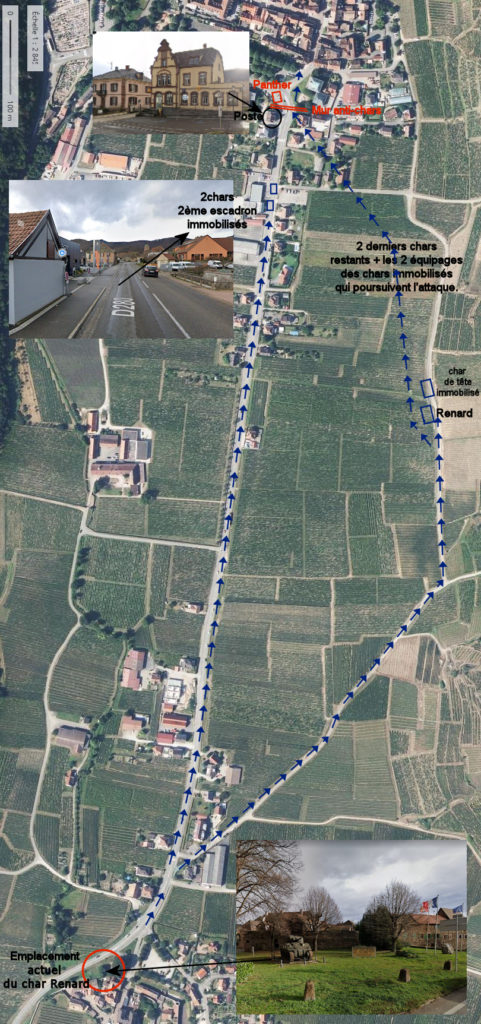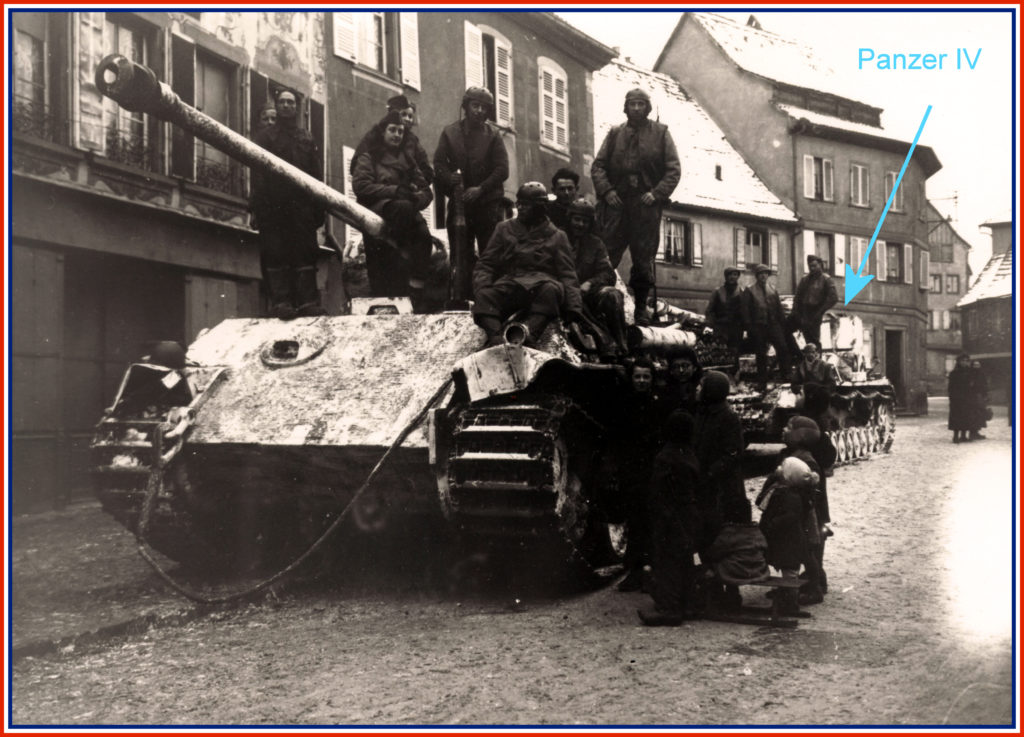Jacques Jean François Henri de VERNEJOUL 1889 – 1969
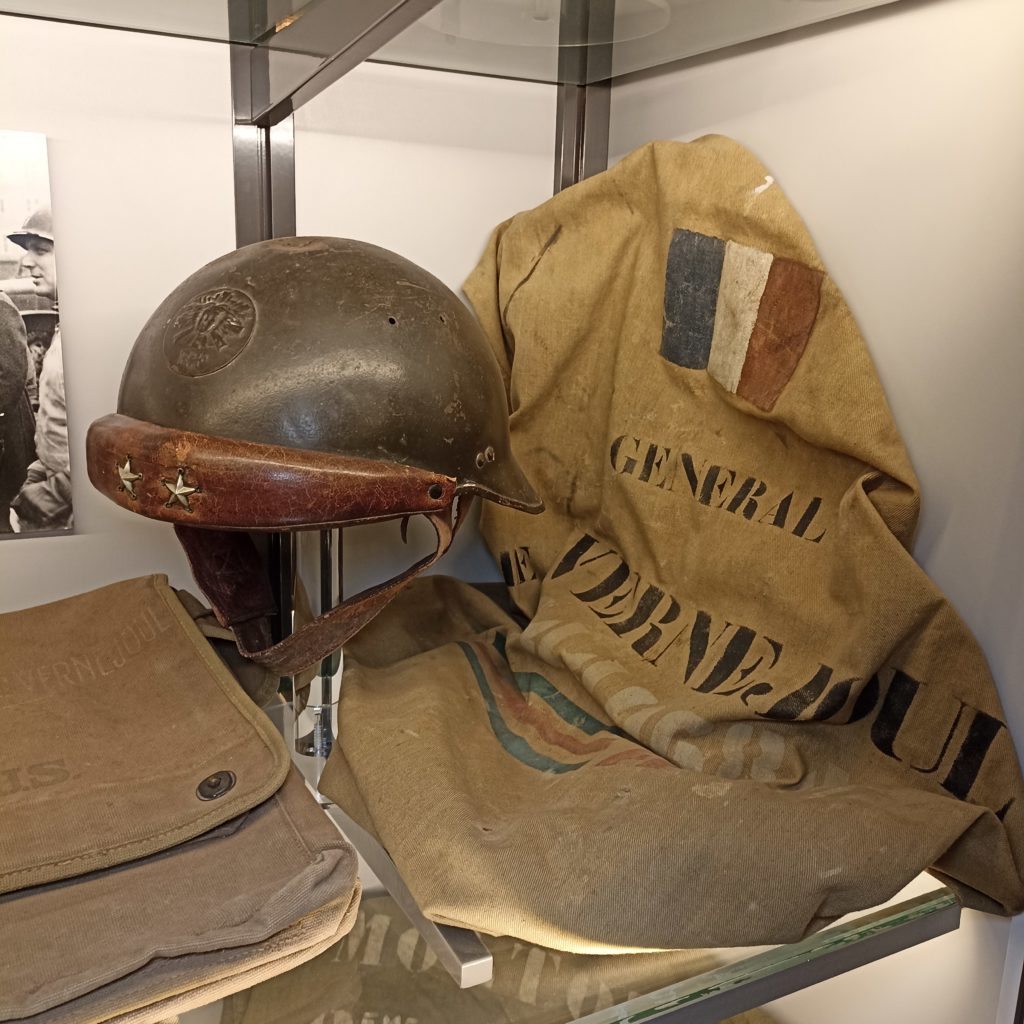
2-star Mle 1935 French motorized helmet worn by General De Vernejoul, along with his canvas bag, compass, map reader and map holder used during the fighting in the Colmar pocket (donated by the De Vernejoul family).
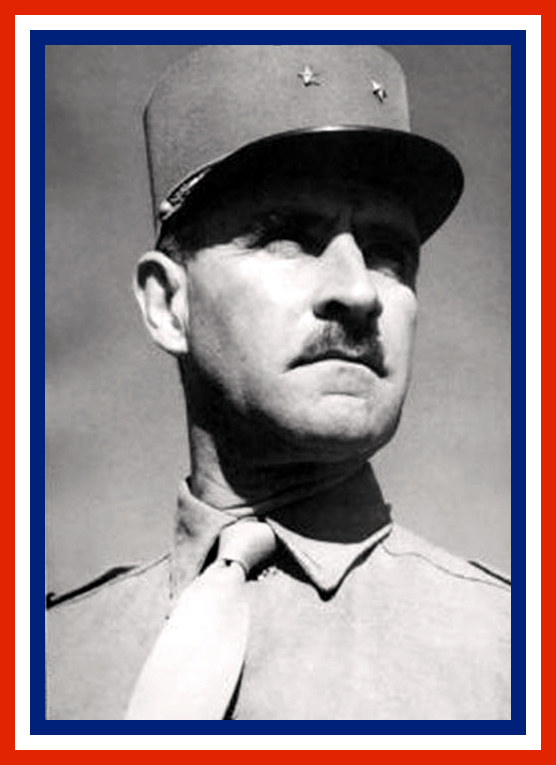
My name is Jacques, Jean-François, Henri de Vernejoul.
I was born on May 13, 1889 in Montcaret, Dordogne, the son of Jean-François, Edgar, a pastor, and Lucy-Fanny-Delphine Laurens.
With a bachelor’s degree in Latin and science, I passed the Saint-Cyr entrance exam in 1910.

Before entering the school I had to do a year’s military service.
On 10/13/1910, I was drafted into the 19th Carcassone dragoon regiment as a second-class cavalryman.
I was promoted to the rank of brigadier on February 13, 1911, then maréchal des logis on September 14 of the same year.
On October 11, 1911, I entered the École Spéciale Militaire de Saint-Cy as a midshipman, graduating 2 years later ranked 74th out of 249 students.
NB: his captain already noted his “great qualities as an instructor and leader”, and described him as “very military, very conscientious, worthy of all confidence” and as an “elegant, skilful and fine horseman.”
On July 10, 1913, I was promoted to second lieutenant and posted to the 19th Dragoon Regiment in Carcassonne. From October 1913 to August 1914, I attended the École d’Application de Cavalerie in Saumur (9th out of 68 student second lieutenants, with honors). On graduating, I joined the 4th Hussar Regiment in Reims.
Mobilized with this same regiment, I took part in the battle of Charleroi (21-23/08/14), the battle of Guise (29/8/14), the battle between Béthune and Lens, and the battle between Hazebrouck and Estaires in October 1914, where I distinguished myself by leading a reconnaissance in the Estaires sector, earning my first citation on October 24, 1914, which read as follows: “Led a reconnaissance on Estaires with energy and composure, and also showed the best spirit of solidarity and sacrifice by holding out under heavy artillery fire and at a spotted position where he lost two horses out of four, in order not to draw fire on lines of French dragoons coming up to his level. “
In 1915 I was promoted to Lieutenant and left the cavalry to join the 6th Battalion of Alpine Chasseurs, with whom I took part in the Battle of the Linen in the Vosges.
NB: On July 25, 1917, he was cited in the Brigade Order: “Caught under a violent and sudden barrage in the support line with his platoon at work, managed under a very violent bombardment to reunite his platoon and move it to its combat positions, demonstrating the utmost calm and composure despite the shock of a shell which threw him to the ground and partially covered him.
I took part in the great offensive of the summer of 1918, during which I was wounded in the right thigh by 2 bullets on July 12 at the Anchin farm in the Somme, just as I was getting up to take stock of the situation.
On August 9, 1918, I was cited in the Army Order: “Officer of great valour and unfailing bravery, commanding a front-line attack company, was seriously wounded while leading his men in an assault on enemy positions, always remaining on his feet despite violent machine-gun fire, thus giving the finest example of courage. Two previous commendations.
On November 4, 1918, back at the front, I was again seriously wounded by a bullet to the left shoulder as I led my men over the Sambre canal.
NB : surmontant sa douleur, il reste à son poste, inspirant confiance à tous par son calme, mais au moment où il retraverse le canal, une autre balle lui brise le bras droit. Évacué, il recevra la croix de chevalier de la Légion d’honneur le 7 juillet 1919 (rang du 8 novembre 1918) avec la citation suivante : « Officier d’élite, remarquable par son dévouement. Le 4 novembre 1918, au canal de la Sambre, a pris, sous un intense bombardement et sous un feu violent de mitrailleuse, le commandement du restant de deux compagnies qui venaient de perdre leur chef et s’est présenté pour entrainer ses chasseurs sur une passerelle violemment battue. Atteint une première fois, a continué sa marche et a reçu une deuxième blessure. Une blessure antérieure. Trois citations. »
Le 25 décembre 1918, j’obtiens une citation à l’ordre de la brigade : « Pendant une année d’opérations décisives et interrompues du bois Sénécat au canal de la Sambre par Moreuil et Vauxaillon s’est montré en toutes circonstances le premier chasseur de sa compagnie. »
Je termine la première guerre avec 5 citations et trois blessures de guerre.
Malgré ce « beau palmarès », je n’obtiens pas le grade de capitaine auquel je pouvais prétendre pour mes faits d’armes comme commandant de compagnie, et pour lequel j’avais été proposé plusieurs fois.
NB : cet « oubli » ne sera pas sans conséquences sur son avancement futur et les emplois occupés.
Le 16 janvier 1920, après plusieurs mois passés à l’hôpital, je retrouve le 4ème régiment de Hussards.
Le 1er septembre 1921 je me marie avec Thérèse Thierry-Mieg (originaire de Thann en alsace) avec qui nous aurons 6 enfants.
Promu capitaine le 23 décembre 1921, affecté au 14e régiment de Dragons le 19 janvier 1922, j’entre à l’École d’Application de Cavalerie de Saumur le 7 août pour y suivre le cours des lieutenants d’instruction, et où j’obtiens la mention Très bien. Je reste à ma sortie à l’Ecole d’Application de Cavalerie comme instructeur d’équitation.
Volontaire pour servir au Maroc, j’embarque le 20 juin 1925 et rejoint le 1er escadron du Maroc du 7ème régiment de Spahis. Placé à la tête de cette unité, je participe aux opérations les plus dures de la guerre du Rif et me distingue notamment à la prise d’Amerghou en août 1925 et lors de l’attaque de l’Adjer-Abbès en septembre.
NB : Il obtient une citation à l’ordre de la 3e Division d’Infanterie de Marche du Maroc et la Croix de guerre des théâtres d’opérations extérieurs le 15 janvier 1926 : « Officier de toute valeur, a su par son entrain et son sang-froid obtenir le maximum de tout son escadron en opérations depuis trois mois. S’est particulièrement distingué à la prise de l’Amerghou le 8 août et à l’attaque de l’Adjer-Abbès le 5 septembre 1925. »
Le 8 février 1926, mon escadron étant rapatrié en Algérie, et en raison de mes connaissances en matière équine, j’occupe le poste de capitaine acheteur au dépôt de remonte et d’étalons de Mazagan (96 kms de Casablanca).
Rapatrié le 21 juin 1927, je suis affecté comme instructeur d’équitation à l’École d’Application de Cavalerie de Saumur (pendant 5 ans), où je forme toute une génération d’officiers. Par la même occasion je participe en tant qu’écuyer du Cadre noir à de nombreux concours hippiques pendant cette période.
En 1933 j’obtiens le 4ème prix de dressage lors de l’épreuve internationale qui se déroule à Vienne en Autriche.
NB : Il n’en néglige pas pour autant le remplacement du cheval par le moteur et se montre un fervent soutien du général Flavigny grand l’artisan de la mécanisation de la cavalerie française. En avril-mai 1933, je suis le cours de franchissement du grade de chef d’escadrons.
Promu chef d’escadrons le 24 septembre 1933, je prends le 6 juin 1934 le commandement du 5ème groupe d’automitrailleuses. Du 10 avril au 6 mai 1935 je suis le cours des commandants de formations motorisées.
Pressenti pour prendre part aux Olympiades de Berlin je ne suis finalement pas sélectionné.
Je suis nommé au grade d’Officier de la Légion d’Honneur le 19 décembre 1934.
Le 15 octobre 1936, je suis muté en tant que commandant en second au 8ème régiment de cuirassiers à Saint-Germain-en-Laye. Le général Altmayer, inspecteur général de la cavalerie, note à mon propos en octobre 1938 : « Toujours excellent. Véritable chef d’unité mécanique et motorisée. » La même année, je suis le cours des officiers supérieurs à Saumur.
Promu Lieutenant-colonel le 24 mars 1939, je passe au 1er régiment de hussards, à Angers, comme commandant en second. Du 14 au 27 mai, je suis le cours des commandants de groupement d’artillerie à Mailly(71).
Le 2 septembre 1939, je suis mobilisé à la tête du 7ème Groupe de Reconnaissance de Division d’Infanterie (1ère DIM). Après avoir stationné dans la région Sud-Est de Cambrai, puis à Bohain et Premont dans l’Aisne, le 7ème GRDI fait mouvement sur Sézanne le 1er octobre 1939, puis sur la région de Lassigny le 5 novembre 1939. Dans cette période, je m’attache à former mes hommes aux terribles combats qui se préparent.
NB : pendant cette période il est reconnu comme un chef à la fois ferme et bienveillant.
Affecté le 14 novembre 1939 au centre d’organisation mécanique de la cavalerie (COMC) de Fontevrault, je reçois le 1er janvier 1940 le commandement du 1er régiment de cuirassiers et qui avec le 2ème régiment de cuirassiers de mon ami le Lieutenant-colonel Touzet du Vigier (futur Général Commandant la 1ère DB) nous formons la 5e Brigade Légère Mécanique (BLM) du général de Lafont, intégrée à la 3e Division Légère Mécanique (DLM) du général Langlois.
NB : Henri de Vernejoul apporte dans ses nouvelles fonctions toutes ses qualités d’organisateur, d’instructeur et de chef qui lui ont été reconnues partout où il a servi. En quelques semaines, malgré la jeunesse et le manque d’expérience de ses cadres, il réussit à former des escadrons de combat prêts pour la bataille au point de vue technique, tactique et moral.
Le 10 mai 1940, après un séjour de 6 semaines au camp de Sissonne j’entre en Belgique avec le reste de la 3e DLM (corps de cavalerie Prioux) dans le cadre de la manœuvre Dyle. Le 13 mai, dans le secteur de Jauches (au Nord-Est de Gembloux), les chars du régiment livrent leur première bataille. Je lance sur le flanc de la IVe Panzerdivision trois pelotons de Somua. En quelques minutes, nos chars français détruisent un grand nombre de panzers. Mais cette victoire est sans lendemain, car l’irruption des forces motorisées allemandes à Sedan oblige le commandement français à ordonner l’évacuation de la Belgique. Le 1er régiment de cuirassiers se replie avec le reste de la 3e DLM. NB : dans les circonstances les plus difficiles, de Vernejoul maintient ses unités au plus haut degré d’agressivité luttant et contre-attaquant sans répit en particulier aux Quatre-Bras près d’Arras et vers Armentières.
Embarqué à Dunkerque le 1er juin avec tous ses équipages démontés, il parvient par son exemple personnel, et malgré les exemples déprimants des arrières du champ de bataille, à conserver à ses équipages toute leur vigueur morale.
Le 3 juin 1940 je reviens en France et refuse d’abandonner la lutte.
Je reforme en Normandie, avec les restes de mon régiment, une troupe improvisée de combattants à pied autour de laquelle se regroupent peu à peu des éléments variés : infanterie, section d’artillerie, groupe franc de cavalerie. Toujours dans le cadre de la 5e BLM, désormais commandée par le Lieutenant-colonel Touzet du Vigier, je poursuis le combat avec cette unité, que nous arrivons à transformer en un bloc cohérent. Nous nous replions vers la Loire où j’organise la défense sur un front de 40 km entre Candes et Savonnières (Indre-et-Loire). Pendant 3 jours et 2 nuits, du 18 au 20 juin 1940, nous bloquons l’avance de forces allemandes bien supérieures aux notres sur le fleuve, au pont (encore intact) de Port-Boulet à l’Est de Saumur. Nous nous replions par la suite sur la Clain, sur la Charente puis vers Nontron (Dordogne), où nous nous trouvons lorsque l’armistice est signé.
NB : pour son action en mai et juin 1940, de Vernejoul sera fait commandeur de la Légion d’honneur le 23 août 1940, avec la citation suivante : « Splendide chef de corps, donnant à tous l’exemple des plus rares vertus militaires. Tous les chars de son régiment de combat détruits par le feu, a refusé d’abandonner la lutte et a transformé spontanément ses équipages en combattants à pied. Avec des effectifs très réduits, autour desquels, grâce à son énergie, des formations très variées sont venues s’amalgamer peu à peu, a organisé et conduit la défense de la Loire sur un front de 40 kilomètres, de Candes à Savonnière. A réussi à interdire le passage du fleuve à des forces très supérieures au pont de Port-Boulet, pendant trois jours et trois nuits (18, 19 et 20 juin 1940). »
Il est également compris dans la citation à l’ordre de l’armée de la 5e BLM (1er et 2e cuirassiers) en date du 9 juin 1940 : « Unité de nouvelle formation, instruite par des chefs éminents : le général de Lafont, le colonel du Vigier (2e RC), le lieutenant-colonel de Vernejoul (1er RC) qui surent lui communiquer leur esprit du devoir et leur foi. Après une marche à l’ennemi, longue et rapide, mettant déjà à l’épreuve l’énergie des équipages de chars, ces unités sont entrées d’emblée avec un allant magnifique dans la fournaise du combat sous les ordres de ces mêmes chefs qui les avaient instruites, luttant victorieusement contre les unités mécaniques allemandes, arrêtant leurs attaques et les contre-attaquant sans arrêt, permettant ainsi à la DLM, du 10 au 13 mai 1940, de remplir sa mission. Employés ensuite, du 14 au 23 mai, soit dans le cadre de grandes unités attaquées par des engins blindés, soit dans le cadre de la DLM, ces régiments ont affirmé la même ardeur et le même mépris du danger. La 5e BLM (1er et 2e cuirassiers) peut être citée en exemple de ce que peut faire une troupe instruite, disciplinée, ayant l’esprit de camaraderie, de devoir et de sacrifice. »
Maintenu dans les cadres de l’armée d’armistice, je reçois le 7 août 1940 le commandement du 11ème régiment de Dragons. Le 1er septembre 1940, je passe à la tête du 12ème régiment de cuirassiers, à Orange et suis promu colonel le 25 mars 1941.
Le 9 mai 1941, je pars pour le Maroc où je dois prendre le commandement du 1er Régiment de Chasseurs d’Afrique, à Rabat, en remplacement du colonel Dor de Lastours.
Le 24 juillet 1942, je suis nommé adjoint au général Leyer, commandant de la cavalerie du Maroc.
Dans la nuit du 8 novembre 1942, alors que les troupes américaines commencent à débarquer à Casablanca, je suis appelé au téléphone par le général Noguès, résident général et commandant en chef des troupes du Maroc, qui m’apprend qu’il est bloqué par des éléments rebelles du RICM du colonel Magnan, agissant sur ordre du général Béthouart. Aussitôt, je préviens le commandant du 1er RCA, qui parlemente et finit par libérer la résidence. Peu après, le 1er RCA et le 1er Régiment de Tirailleurs Marocains sont engagés contre les Américains débarqués dans la zone de Port-Lyautey. Des combats meurtriers nous opposent aux Américains pendant 2 jours (le 1er RCA perd une dizaine de chars).
NB : Les Américains, qui manquent d’être rejetés à la mer, menacent de bombarder Casablanca lorsque le cessez-le-feu intervient, sur ordre de Darlan qui a pris entre-temps le commandement des forces françaises d’Afrique du Nord (10 novembre). Le 12 novembre, il succède au général Leyer à la tête de la cavalerie du Maroc. Il est promu général de brigade à titre temporaire le 24 décembre 1942.
Le 1er mai 1943, je suis placé à la tête de la 2ème Division Blindée créée à Rabat. Cette division prend le numéro 5 le 1er juin 1943, le numéro 2 ayant finalement été attribué à la division blindée commandée par le général Leclerc. En septembre 1943, la division s’équipe avec le matériel livré par les Américains et débarqué à Casablanca en avril et en mai, puis en septembre 1943.
Je suis prend en charge l’entraînement de ma Division blindée au Maroc et en Oranie. Après la réussite du Débarquement de provence le 15 août 1944 et 17 mois d’entraînement intensif, ma 5ème DB est prête au combat et quitte l’Oranie en septembre 1944. La division débarque en France, où elle est rattachée à la 1re Armée Française du général de Lattre. Le 2 octobre, elle est regroupée en Provence.
La 5e DB est transférée par voie ferrée dans le secteur de Vesoul, où elle se concentre à la fin du mois d’octobre 1944. A partir du 3 novembre, le Combat Command 6 (CC6) du colonel Tritschler est engagé dans la vallée du Bouchot dans le cadre des opérations de diversion menées par le 2ème Corps d’Armée français dans les Vosges et destinées à faciliter la percée du 1er Corps d’Armée français dans la trouée de Belfort. Ces combats, menés sur un terrain peu favorable, s’achèvent le 6 novembre 1944.
Le 14 novembre, les chars du général de Vernejoul participent aux opérations de la trouée de Belfort, contribuant de manière décisive à la rupture du front à Héricourt et à Montbéliard. La division est ensuite lancée dans le sud de l’Alsace où elle atteint la rivière Doller. Ses Combat Command 4 et 5 (CC4 et CC5) participent à la manœuvre de Burnhaupt (20 au 26 novembre) qui se solde par l’encerclement du LXIIIe corps d’armée allemand. Le 28 novembre, la division s’aligne sur la Doller, prête à foncer vers le nord à partir du Pont-d’Aspach, vers Colmar, afin de tendre la main à la 2e DB venue de Strasbourg (libérée le 23/11/1944). Mais, le 30 novembre, le général de Lattre commandant de la 1ère Armée française annule cette opération.
La Division se met alors sur la défensive avant d’être retirée du front…ce qui sera vivement dénoncé par le Général de Vernejoul. A la fin du mois de décembre, le CC5 est envoyé dans la région d’Obernai(67) afin de relever la 2e DB. Le 5 janvier 1945, il est mis à la disposition de la 3e Division d’Infanterie AlgérienneA afin de participer à la défense de Strasbourg, menacée par le retour offensif allemand lié à la bataille des Ardennes.
Le 17 janvier 1945, le général de Vernejoul est cité à l’ordre de la 1ère Armée française: « Officier Général ayant au plus haut degré le sens du devoir et de l’honneur. Par son expérience de l’arme blindée, son rayonnement personnel et sa foi patriotique, a su faire de la 5e DB une grande unité d’élite qui, engagée dès le 15 novembre dans les Vosges et en Alsace, a livré victorieusement les combats acharnés de Héricourt, Montbéliard, Belfort, Dannemarie, Thann et Kaysersberg, capturant à l’ennemi plusieurs milliers de prisonniers et un abondant matériel en lui infligeant des pertes sévères. Vivant au contact de ses troupes, partageant leur gloire et leurs fatigues, est pour tous un symbole et un exemple. Quatre fois blessé. Titulaire de huit citations. »
Du 20 janvier au 9 février 1945, la 5e DB, rattachée au 21e corps d’armée américain, participe aux combats de la réduction de la poche de Colmar. Le 2 février 1945, son CC4 du général Schlesser pénètre dans Colmar. Nommé gouverneur de Colmar, Henri de Vernejoul assure le nettoyage de l’agglomération. Jusqu’au 9 février, le reste de sa division réduit les derniers nids de résistance.

Photo prise à Colmar le 2 février 1945 avenue de la République.
De gauche à droite : le maire Edouard Richard (avec les lunettes et le béret) – le préfet Fonlupt-Espéraber – le général de Vernejoul – le général Schlesser du CC4.
Après les combats de Colmar, il reçoit la Bronze Star américaine pour services éminents rendus au combat du 26 au 30 janvier 1945 : « Le général de Vernejoul a dirigé les opérations de sa division blindée avec autant d’audace que de brillante intelligence tactique a l’appui de la 3e division d’infanterie américaine au Nord et à l’Est de la ville de Colmar. Appuyant invariablement l’infanterie de ses chars lorsqu’il le fallait, le général de Vernejoul a fait manœuvrer ses blindés fort habilement détruisant les points fortifiés de l’ennemi et ses arrière-gardes avec la plus grande rapidité. »
Il est également fait commandeur de la Legion of Merit pour « ses dons de chef et sa coopération de tout cœur avec les unités américaines, participant efficacement au succès de la campagne qui réduisit la poche de Colmar. Sa division traversa le canal de Colmar en étroite liaison avec les 3ème et 28ème divisions américaines et occupa la ville de Colmar. Grâce à son habileté tactique et sa dévotion tenace, à l’esprit du devoir, le général de Vernejoul contribua grandement au succès des opérations qui chassèrent l’ennemi de la Basse-Alsace à l’Ouest du Rhin. »
Après plusieurs semaines d’inaction, la 1ère Armée française repasse à l’offensive le 15 mars 1945 avec, pour objectif, le franchissement du Rhin et la conquête du Sud-Ouest de l’Allemagne. Le CC6 est engagé aux côtés de la 3e DIA lors de l’opération préliminaire sur la Lauter (15 au 18 mars), puis lors de l’assaut de la ligne Siegfried. Le 25 mars, il est promu général de Division.
La 5ème Division Blindée franchit ensuite le Rhin à Mannheim. Le CC4 participe à la prise de Karlsruhe avec la 2e Division d’Infanterie Marocaine (4 avril) tandis que le CC5 atteint le Neckar. Avec la 1ère DB, la 5ème DB prend part à la manœuvre de Freudenstadt. Au cours de ces opérations, et pour la première fois de la campagne, le général de Vernejoul a ses trois Combat Command sous ses ordres directs. Parti de Pforzheim, il lance ses chars vers le sud en direction de la capitale du Wurtemberg, Stuttgart, dont il s’empare le 21 avril.
Le 16 mars 1945, la 5e division blindée est citée à l’ordre de l’armée : « Magnifique division blindée, animée du plus noble idéal et du plus pur esprit de devoir et de sacrifice. Sous les ordres d’un chef à l’âme haute, le général de Vernejoul, la 5e division blindée a combattu sans désemparer un ennemi ardent et tenace dans les terrains les plus difficiles pour lui arracher de haute lutte la terre sacrée d’Alsace. Engagée en division ou en groupements tactiques, seule ou en liaison intime avec les unités d’infanterie françaises et américaines, a contribué au succès de nos armes dans la trouée de Belfort, dans les Vosges et en Alsace, infligeant à l’ennemi des pertes très sévères, lui capturant plus de 6 000 prisonniers et un abondant matériel de guerre. S’est particulièrement distinguée à Montbéliard, Héricourt, Belfort, Dannemarie et à Thann lors de la course sur Mulhouse et au cours de la progression en Haute-Alsace, puis à Orbey, Kaysersberg, Kientzheim, Ensisheim lors de la première poussée sur Colmar. A pris enfin une part décisive à l’offensive sur Brisach et à la libération de Colmar, subissant sans faiblir les chocs les plus rudes, à la pointe du combat, ouvrant la voie à l’infanterie, se mêlant à elle pour repousser les ultimes assauts d’un ennemi acharné à défendre les derniers arpents d’une terre française qui a toujours été l’enjeu d’une lutte plusieurs fois séculaire. S’est montrée ainsi en toutes circonstances l’égale des plus belles unités qui ont fait l’honneur et la gloire de la cavalerie française. »
Mais, le 22 avril, à cause de divergences de vues avec le général de Lattre, il est obligé de céder le commandement de la 5ème DB au général Schlesser.
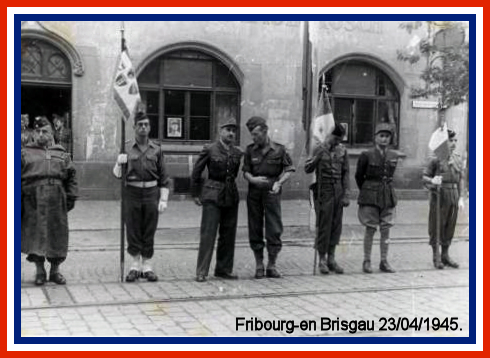
Le 15 novembre 1946, la 5e division blindée sera citée une seconde fois à l’ordre de l’armée : « Grande unité blindée qui, sous l’énergique conduite du général de Vernejoul, a été intimement mêlée à toutes les actions et à tous les succès du 2e corps d’armée. Dès le débouché de la forêt de Haguenau et au cours de la percée de la ligne Siegfried, le CC6 aux ordres du colonel Boutaud de Lavilléon appuie étroitement la 3e division d’infanterie algérienne. Disputant la priorité aux fantassins aux points de passage du Rhin, le CC4 aux ordres du général Schlesser et le CC5 aux ordres du colonel Mozat appuient et entraînent la 2e division d’infanterie marocaine et la 3e division d’infanterie algérienne. Le premier arrache Pforzheim à l’ennemi tandis que le second atteint le Neckar. Puis c’est l’audacieuse action du CC6 qui faisant tête de pont au Sud de l’Enz, oblige l’adversaire à concentrer ses efforts devant la porte qu’il a ouverte sur Stuttgart. Soudant en même temps son action à celle de la 2e division d’infanterie marocaine, en plein cœur de la forêt noire, le CC4 s’enfonce en coin dans les positions âprement défendues par la 257e division. Par la brèche ainsi ouverte, et suivi du CC5 qui se précipite droit au Sud sur les débouchés de Freudenstadt, le CC4 exploit d’un seul élan sur Colm, Negold et Horb. Toute la 5e division blindée dans la main de son chef, est alors découplée vers l’Est. Fonçant sans désemparer pendant 60 heures, elle enlève Tübingen et Reutlingen avec le CC5 et, prenant Stuttgart à revers, elle y pénètre au soir du 21 avril avec le CC4 et le CC6 qui entreprennent aussitôt le nettoyage de la ville. Le CC5, pointant vers le Sud, atteint Sigmaringen, ouvrant ainsi par le Nord la voie du Danube. Puis, tous moyens réunis, la 5e division blindée, sous l’ardente impulsion du général Schlesser, fonce en direction de la frontière autrichienne qu’elle atteint la première le 29 avril 1945. Continuant hardiment sa progression, nettoyant au passage les rives du lac de Constance, elle franchit et dépasse l’Arlberg le 7 mai 1945. Ce raid magnifique achève la désorganisation de l’ennemi après lui avoir enlevé douze mille prisonniers et un important matériel de guerre. La 5e division blindée s’est montrée fidèle aux plus vieilles traditions de la cavalerie française. »
Le 22 avril 1945, il prend le commandement de l’armée blindée et de la cavalerie de la 1ère armée française, poste secondaire qui consiste essentiellement à organiser l’instruction et à gérer le personnel. Il occupe ce poste d’abord auprès du général de Lattre puis auprès du général de Monsabert, commandant supérieur des troupes d’occupation en Allemagne. Il est promu général de division à titre temporaire le 8 mai 1945. Par arrêté du 1er septembre 1945, ses nominations de général de brigade à titre temporaire et de général de division à titre temporaire sont transformées de droit en nominations définitives.
Placé sur sa demande dans la deuxième section des officiers généraux le 15 avril 1946, au bénéfice de l’ordonnance sur le dégagement des cadres, il est élevé à la dignité de grand-officier de la Légion d’honneur le 7 mai 1946 avec 35 ans de services et 12 campagnes.
Retiré dans sa propriété de Chanteyrie à Nyons (Drôme), il se consacre à la culture des oliviers. En 1964, il fonde la confrérie des chevaliers de l’olivier qui se consacre à la reconquête du marché de l’olive par les producteurs des baronnies.
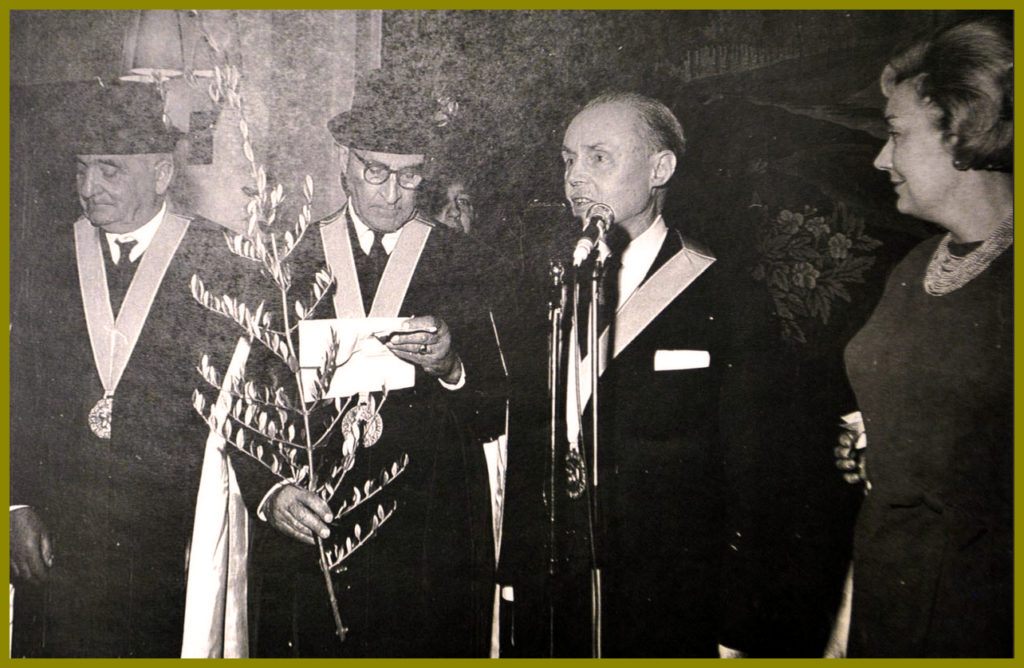
Le général de division de Vernejoul est décédé le 22 août 1969 à l’hôpital civil Édouard Herriot à Lyon (Rhône). Il est inhumé à Nyons.
Ses décorations :
Grand-officier de la Légion d’honneur,
Croix de guerre 1914-1918 (5 citations),
Croix de guerre 1939 (5 palmes),
Croix de guerre des théâtres d’opérations extérieurs (1 citation),
Croix du Combattant,
Médaille coloniale avec agrafe de vermeil « Maroc 1925 »,
Médaille commémorative de la Grande guerre,
Médaille interalliée de la Victoire,
Médaille commémorative de la guerre de 1939-1945 avec agrafes « France », « Afrique », « Libération » et « Allemagne »,
Médaille des Blessés,
Commandeur de la Legion of Merit (États-Unis),
Bronze Star Medal (États-Unis),
Officier avec glaives de l’Ordre d’Orange-Nassau (Pays-Bas).
NB ; avec Armand Durlewanger, il a publié Autopsie d’une victoire morte : essai comparatif non conformiste de la bataille d’Alsace en novembre-décembre 1944, d’après l’étude d’archives françaises et allemandes, de témoignages et de rapports inédits (1970).

Képi et fanion de Commandement du Général de Vernejoul portant la devise de la 5ème Division Blindée “FRANCE D’ABORD” avec sa Croix de Guerre et ses 2 palmes.
Pierre Félix Le FRANC 1920 – 1944
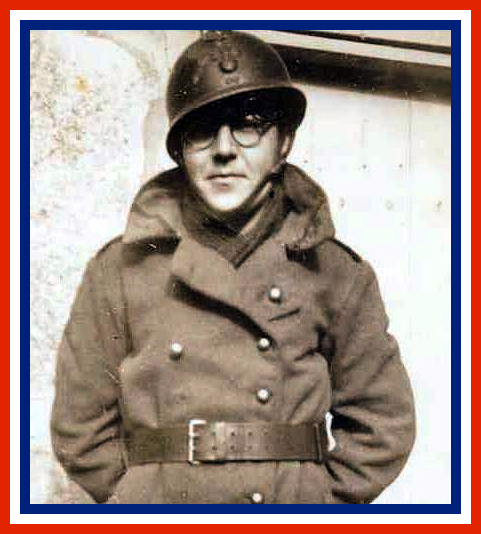
Born in Brest on July 27, 1920, a native of the small village of Le Conquet, with a baccalaureate in philosophy, he joined the army in 1938.
Voluntary enlistment for: three years on: November 7, 1938A l’Intendance Militaire de Brest In the 24th Infantry Regiment
Appointed 1st class on January 28, 1940, then Corporal on April 16, 1940.
Assigned to the 3rd Corps Franc Motorisé on June 3, 1940, and to the 2nd Motorized Cuirassiers Regiment on June 19, 1940.
For his commitment to fire during the Battle of France, he was cited in the Regimental Order on June 25, 1940:
“Engaged in the battle as soon as the 3rd Groupe Franc Motorisé was formed, and separated from its leader following the Moray battle (June 15), it brought its personnel and all its equipment back to the Loire in good order. From June 18 until the armistice, continued to do his duty bravely in the ranks of the 2nd Cuirassiers”.
Pierre Lefranc – place and date unknown (source Lefranc family) :
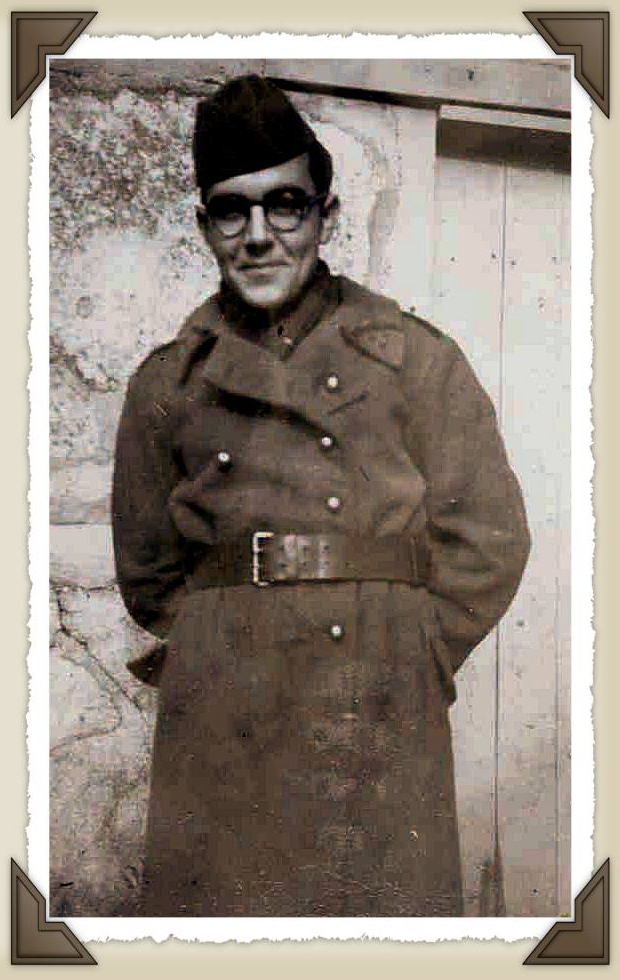
He was then posted successively to the 93rd R.T.S, the 15th R.T.A and the 16th B.C.I.
From January 15, 1941 to July 24, 1941, he attended the preparatory platoon for the grandes écoles in Toulouse.
He was appointed Sergeant on May 15, 1941.
Volunteering for Syria, he was posted to the 7th Algerian Rifle Regiment (7ème RTA) at the end of the preparatory platoon at St Cyr.
He arrived in the Corps on September 8, 1941 with the 7th Cie, then the 9th Cie on November 1, 1941.
He re-enlisted for 1 year on Nov. 14, 1941, then for a further 2 years on October 20, 1942 at the Intendance de Sétif (Algeria).
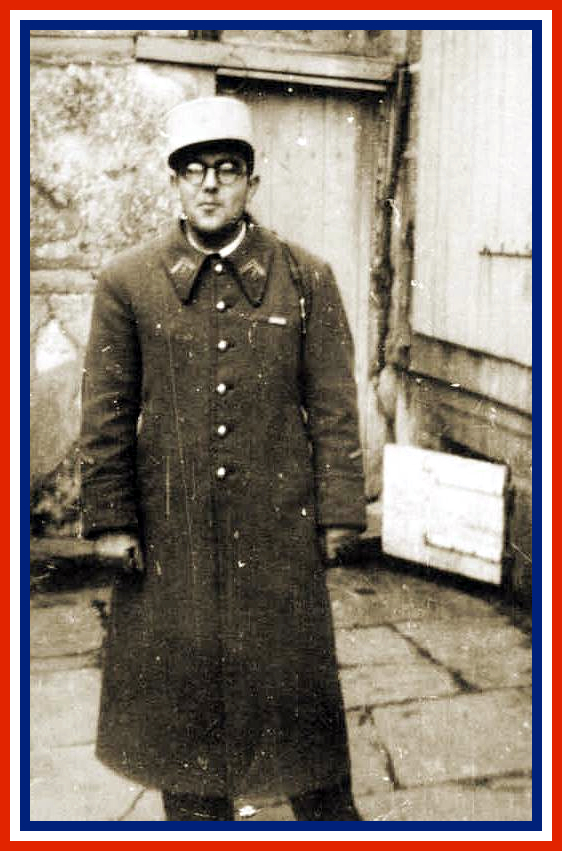
With the 7th RTA, he was awarded a second citation on December 26, 1942, in the Divisional Order:
“At the head of a section of young soldiers who had never experienced fire, on December 3, 1942, spirited them into attacking and then assaulting a strongly held position”.
Croix de guerre 1939-1940 with Bronze Star.
On November 2, 1942, he was sent to the Ecole des Elèves-Aspirants at Cherchell-Médiouna, which trained some 5,000 officers and ranks for the reborn French army from 1942 to 1945.
Appointed “Aspirant d’active” on May 16, 1943, he was assigned to the Bataillon de Parachutistes n°1 (BCP n°1) and was posted to the 5th company on May 23, 1943.
He obtained his brevet Parachutiste d’Infanterie de l’Air on June 15, 1943 (n°1138).
He moved with the regiment from Fez to Oudja on October 7, 1943, for training at the 82nd US Airborne Training Center, from Oudja to Fondouk on December 19, 1943, and from Fondouk to Bordj Ménaiel on January 7, 1944.
On April 5, 1944, it flew from Maison Blanche to Trapani in Sicily. On July 8, 1944, the regiment reached Rome by rail, where it remained until September 5, when the 1st RCP landed in Valence-Chabeuil in the Drôme region of France.
It took part in the Vosges campaign, fighting in the Gehant forest, on the Col du Menil, and on coasts 1008 and 1111.
He was wounded for the first time on October 18, 1944, as recounted in the 5th Company (5ème Cie) logbook:
“At 5:30pm on October 18, 1944, the enemy harassed the 9th Cie sector. Aspirant Le Franc went out on patrol with his platoon, with the mission of assessing the size of the enemy elements. The night is very dark. Aspirant Le Franc is wounded at the start of the action. The patrol returned without result”.
Appointed Second Lieutenant, he joined the 5th Company of the 1st RCP on November 29, 1944.
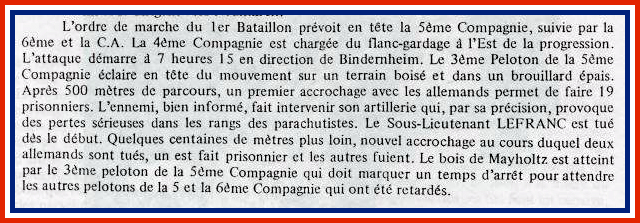
On December 14, 1944, second lieutenant Le Franc lost his life at the age of 24:
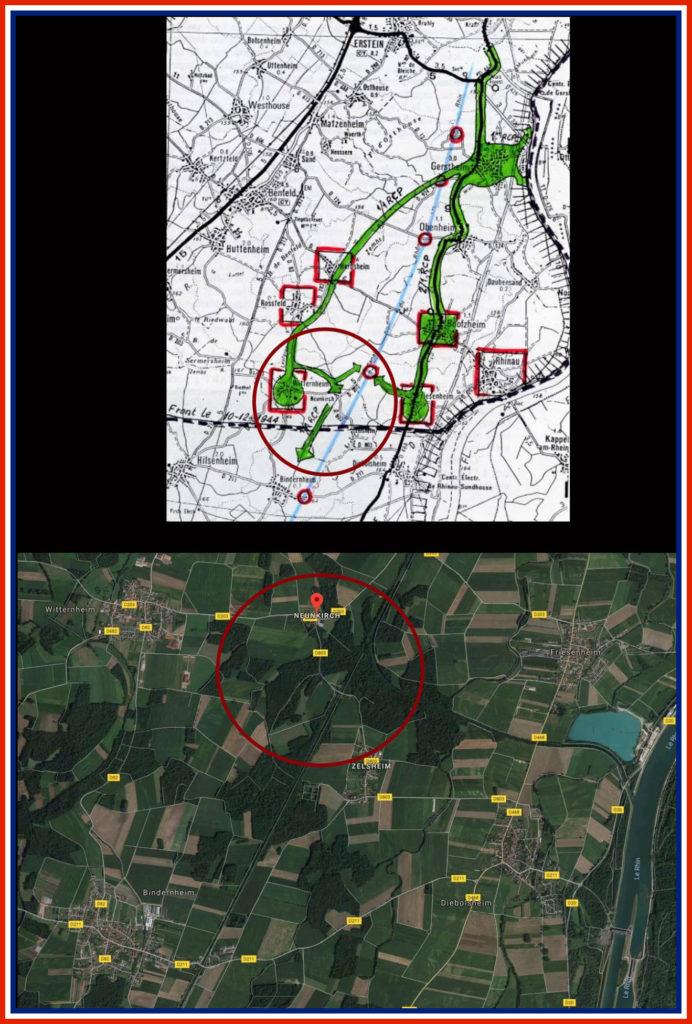
For this last action, he received his third and final commendation; posthumously in the Air Force Order:
“Magnificent platoon leader, of unshakeable courage and tenacity. Never ceased to give of himself at the head of his platoon, paying with his person and always leading his men with an irresistible élan, of whom he had made a team to his devotion. He always kept his faith in victory intact, constantly demonstrating his desire to run into battle and communicating his magnificent fanaticism and cold resolve to those around him. Wounded in action on October 18, 1944, volunteered to return to his unit on December 12, 1944, while on convalescent leave. Died a glorious death on December 14, 1944 in Mayholz wood, while giving orders to maneuver the enemy resistance that was stopping the company”. This citation includes the Croix de Guerre 1939-1945 with palm.
Posthumous commendation in the Order of the Air Force, July 18, 1946 (source: Lefranc family).
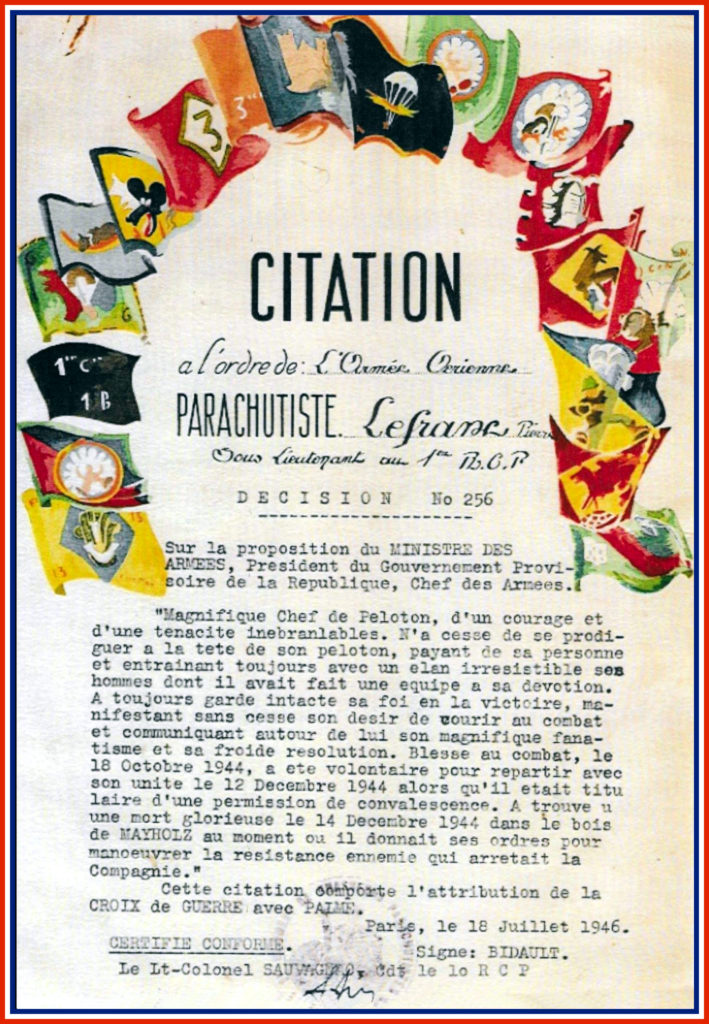
Extract from the history of the 1st RCP – “PHASE OPERATIONNELLE EN ALSACE DU 1 AU 22 DEC 1944” :
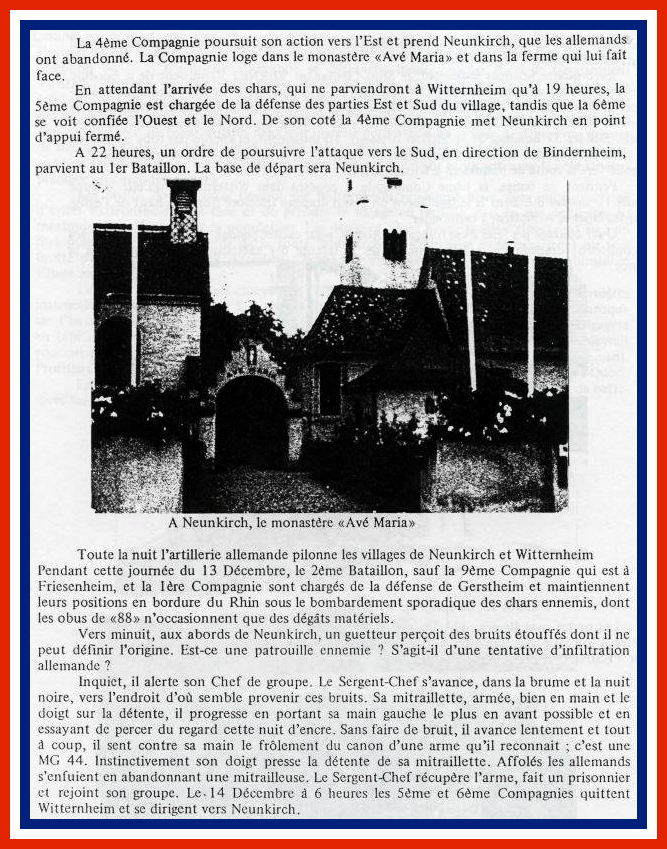
Thanks to his little nephew and his family, we are able to present these rare and precious documents to you today.
We thank them warmly for sharing them with us, so that we can commemorate his memory and that of all those young men who gave their lives to liberate our country from the Nazi yoke.
Pierre GUENAUD 1926 – 1991
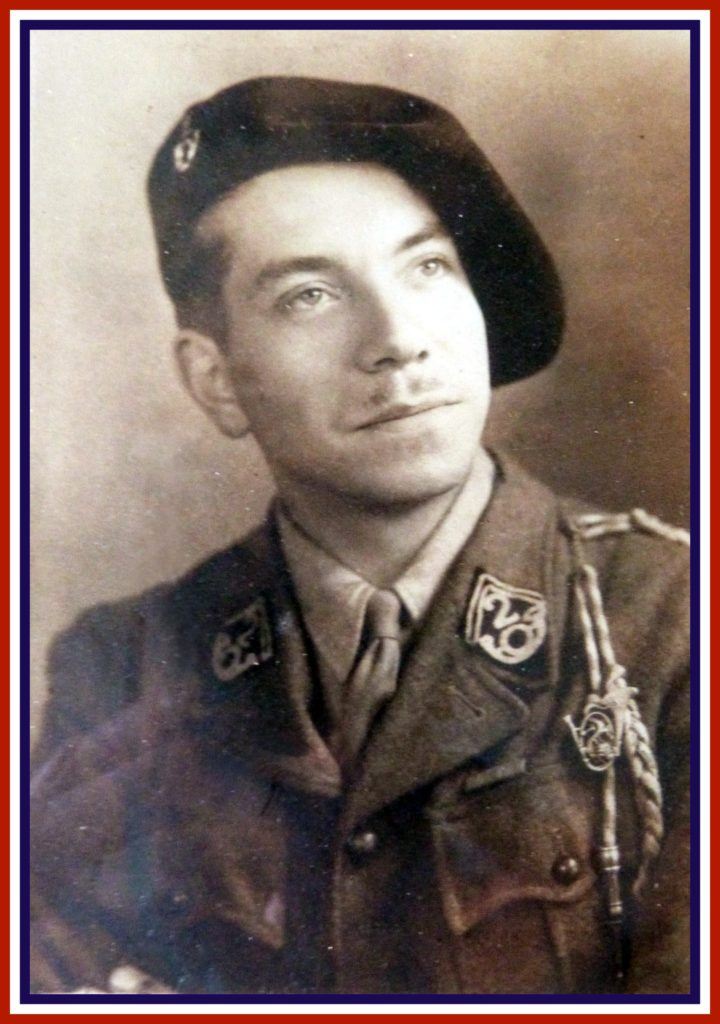
Tribute to Pierre GUENAUD and his comrades of the 2nd Bataillon de Chasseurs à Pied…
Thanks to our research and the acquisition last year of the documents we are publishing today, we are able to pay a heartfelt tribute to Pierre Guenaud and his comrades of the 2nd BCP, liberators who fought bravely to drive out the Nazi invaders.
It’s important for us to regularly recall, through portraits of men and women, what we owe to these hundreds of thousands of “anonymous” fighters who committed themselves to a just cause in the general interest, and that the Freedom we enjoy today was won through the tears and blood of our great elders.
Pierre GUENAUD was born on May 16, 1926 in Montmirey-la-ville, Jura (39).
He was 18 when he joined the FFI of the Groupement du Louhannais in the “HERVEY” company, which was attached to the “FRANCIS” company (from 08-15-1944 to 09-10-1944).
The Maquis du Louhannais gave birth to the 2nd Battalion of Chasseurs à pied, in which Pierre Guenaud voluntarily enlisted on September 10, 1944, for the duration of the war. From September 15, the hunter’s school was launched: basic instruction, individual combat, shooting, marches… to transform these maquisards into infantry soldiers.
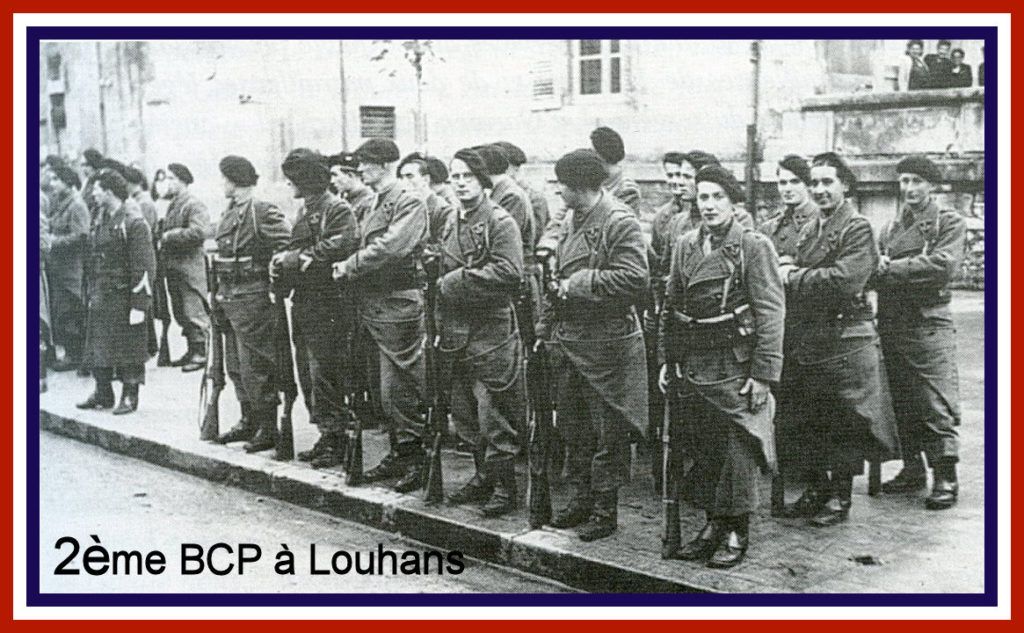
He was promoted to the rank of Corporal on October 25, 1944, by order of Battalion n°5, two days after the battalion had honored General de Gaulle in Dijon.
On November 22, 1944, the 2nd BCP was placed at the disposal of the 1st French Army, which left Louhans in a long line of GMCs and Dodges for Montbéliard, arriving early morning on November 23.
Placed at the disposal of General Béthouard’s 1st Army Corps, it set off again on the evening of November 24, “disembarking” on November 25 at the Buchwald inn, 3 kilometers from Mulhouse, where the battalion set up its headquarters. It was placed in reserve of CC2 of the 1st DB, facing the Hardt forest. In the afternoon, the Battalion moved to the front line, where it suffered its first casualties on November 27, 1944.

The 2nd BCP went into battle in the Hardt forest with the 1st RTM (4DMM) on November 28 and 29.
On December 1, the unit came under the command of the 6th RTM; the first company reinforced it at the Lutterbach bridge, and the 2nd and 3rd Cie relieved the 2nd Battalion of the 6th RTM at the Bourtzwiller and Illzach bridges.
Pierre Guenaud was wounded on December 10, 1944 by a machine-gun bullet to the left arm.
We have found no further information on this subject, but it is likely to have happened along the Doller river (front line), where the 2nd BCP was in a defensive position (Gare du Nord/Bourtzwiller/Illzach sector). The Chasseurs regularly crossed the Doller to feel out and reconnoiter the enemy position (which was also doing the same on its side).
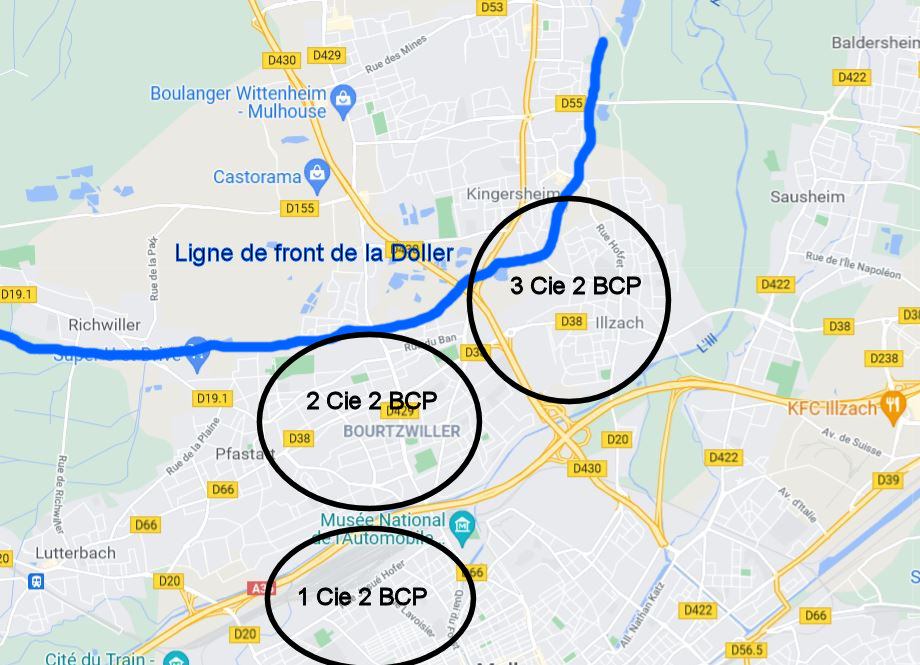
The 2nd BCP returned to the Oelenberg Abbey sector on January 20, 1945, and was deeply affected by the harshness of the fighting. The number of killed (26), wounded (+100) and missing exceeded 75% of the battalion’s strength that day (the battalion would count 57 killed for the entire war), mainly due to the Germans, who had transformed the abbey into a veritable stronghold, with numerous automatic weapons, mortars and minefields, and polar temperatures (around minus 15 degrees).
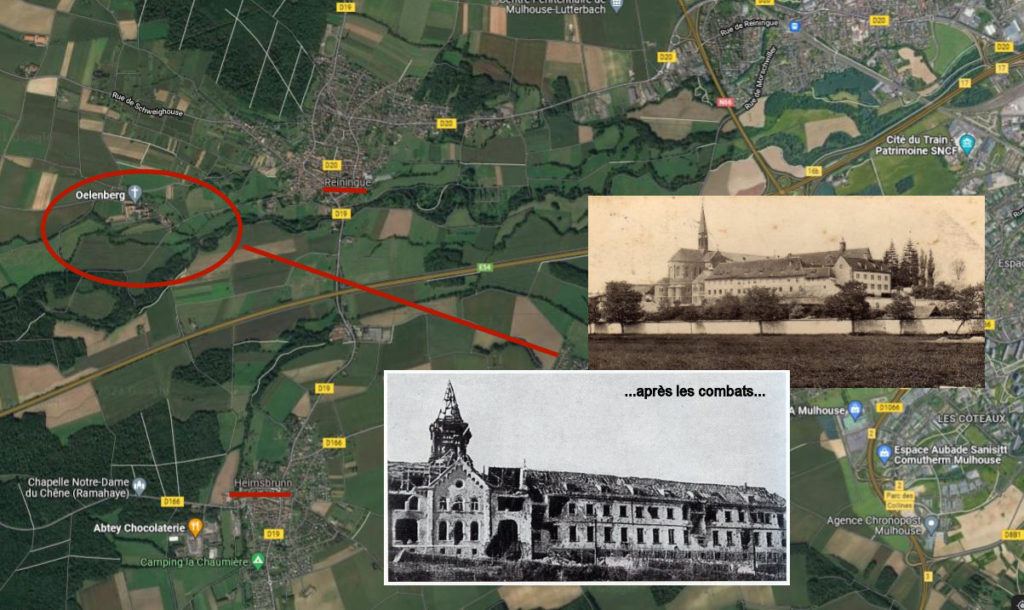
For his special action on January 20, 1945, during the fierce fighting to capture the Oelenberg abbey near Reiningue (68), Pierre Guenaud is cited in the 9th Colonial Infantry Division order:
Citation of General Order no. 34 of March 31, 1945 – Brigadier General VALLUY, 9th Colonial Infantry Division: GUENAUD Pierre, corporal, 2nd Battalion of Chasseurs à Pied.
“First-rate officer, volunteer for the battalion’s corps franc. Remarkably calm in the most difficult situations. On January 20, 1945, during the attack on the Oelenberg convent, demonstrated the finest military qualities at a very delicate moment. Has already been wounded twice, but has always refused to be evacuated”.
This citation includes the Croix de guerre 1939-1945 with silver star.
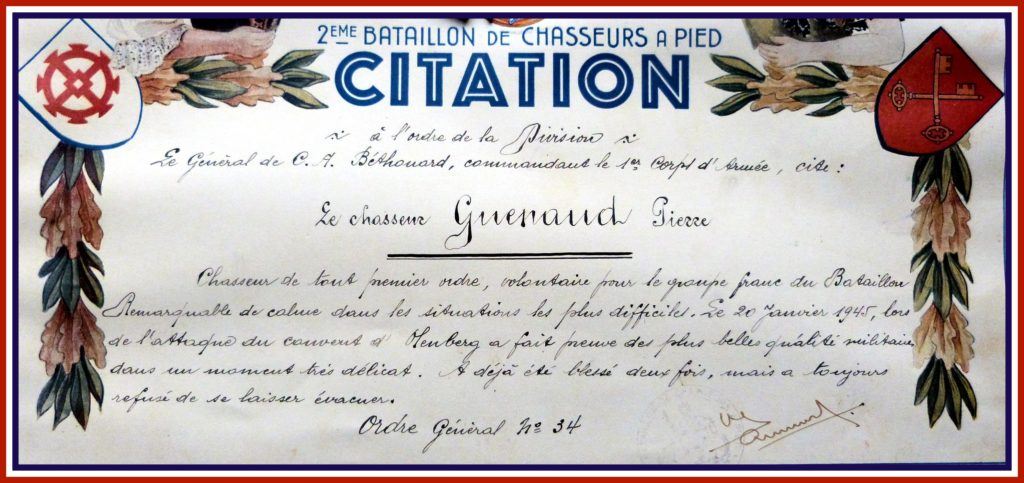
On January 23, 1945, the Battalion was relieved, with around fifty able-bodied men left, the rest either wounded or exhausted by the cold (40 soldiers with frozen feet).
On January 24, the Battalion recovers fallen comrades from the abbey grounds, and gives them a funeral worthy of their sacrifice.
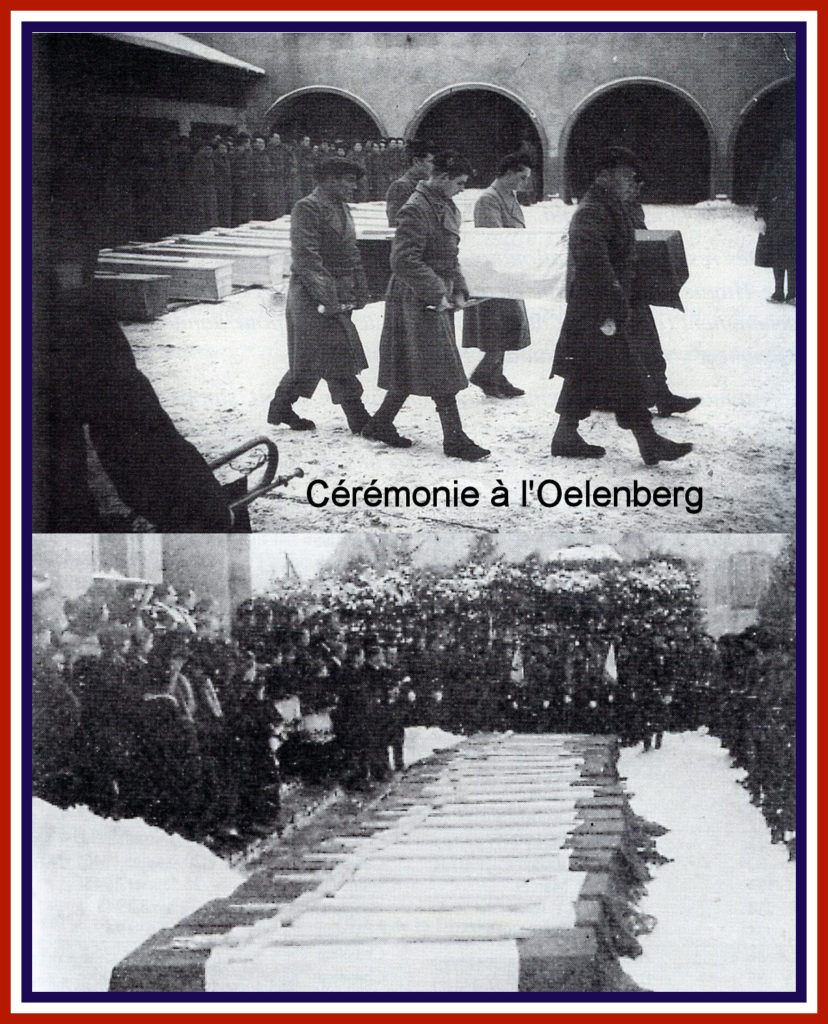
On the 26th, they returned to Mulhouse and billeted at the Wolf School.
On February 12, the Battalion is called up to guard the Rhine in the petit-Landau sector.
On March 25, a parade was held in the Barbanègre barracks in Mulhouse.
From March 30, the regiment guards the Rhine at Plobsheim (67).
On April 6, 1945, it crossed the Rhine into Germany.
Pierre Guenaud was demobilized by the 101 Cie of the 1st Train Squadron on December 23, 1945, and struck off the rolls on December 24, 1945, retiring to Auxonne… where he had his precious documents framed.
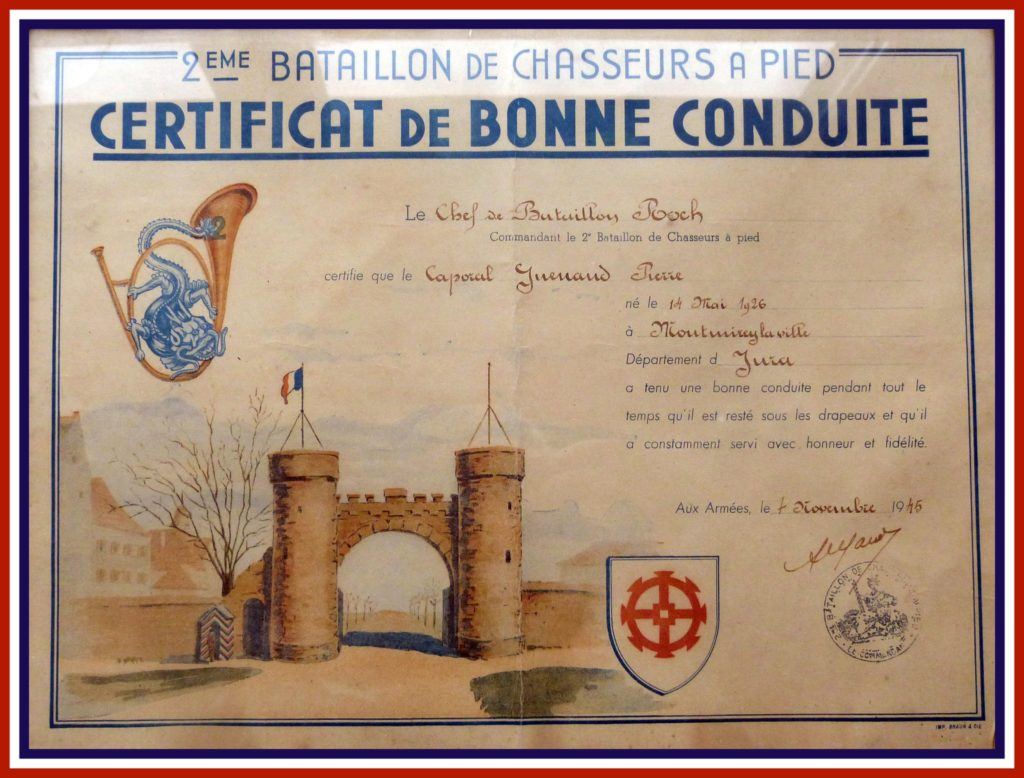
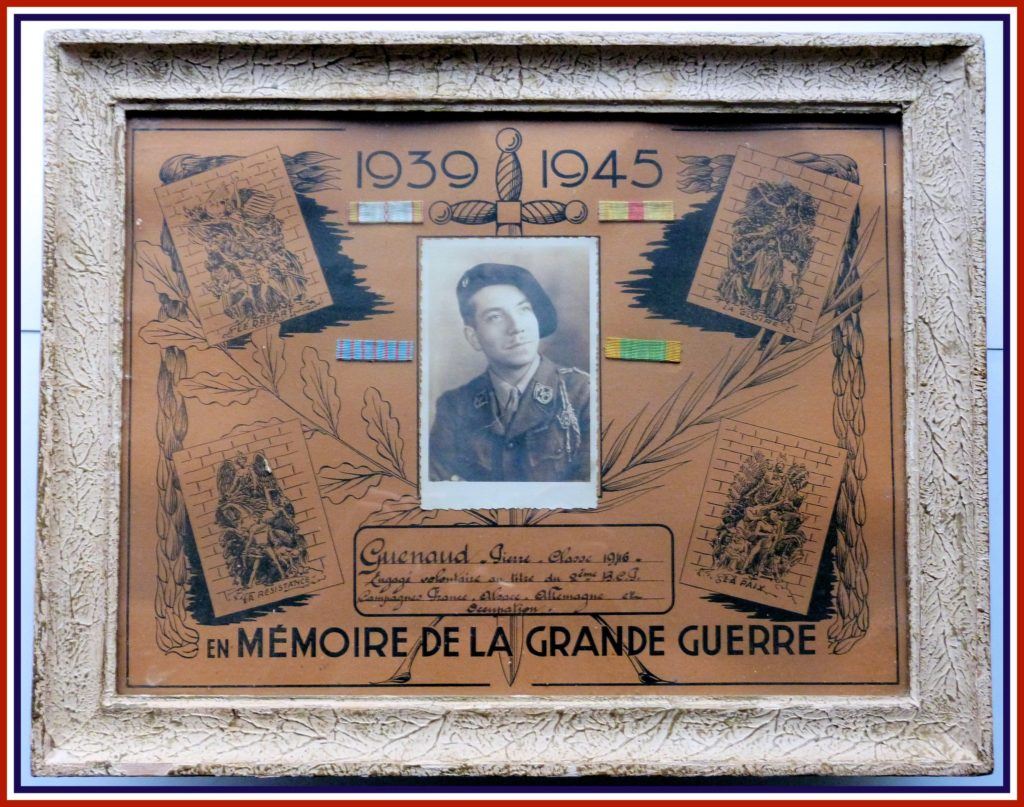
He died on February 10, 1991 in Fontaine-lès-Dijon, Côte d’Or (21).
Source and photos taken from René Pacaut’s book “Maquis dans la Plaine” to complete the account of the regimental history of the 2nd BCP.
NB: It’s interesting to note that for the certificate of good conduct, the illustration shows the entrance to the Barbanègre barracks in Mulhouse, where the 2nd BCP was stationed from 1925 to 1939.
Additional information
Histoire | Abbaye Notre Dame D’Oelenberg (abbaye-oelenberg.com)
2e bataillon de chasseurs à pied — Wikipédia (wikipedia.org)
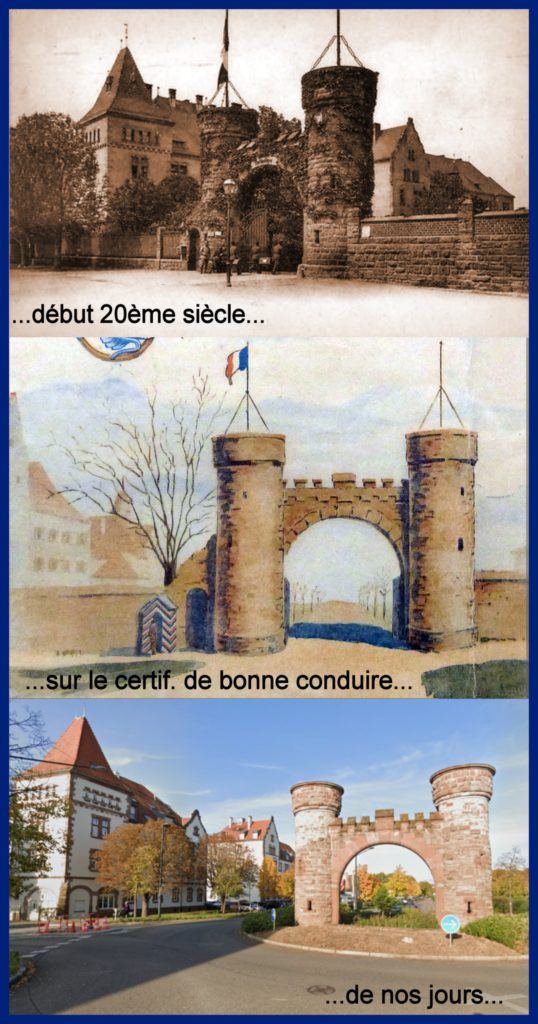
Michel Philippe BROSSOLET 1923 – 1972
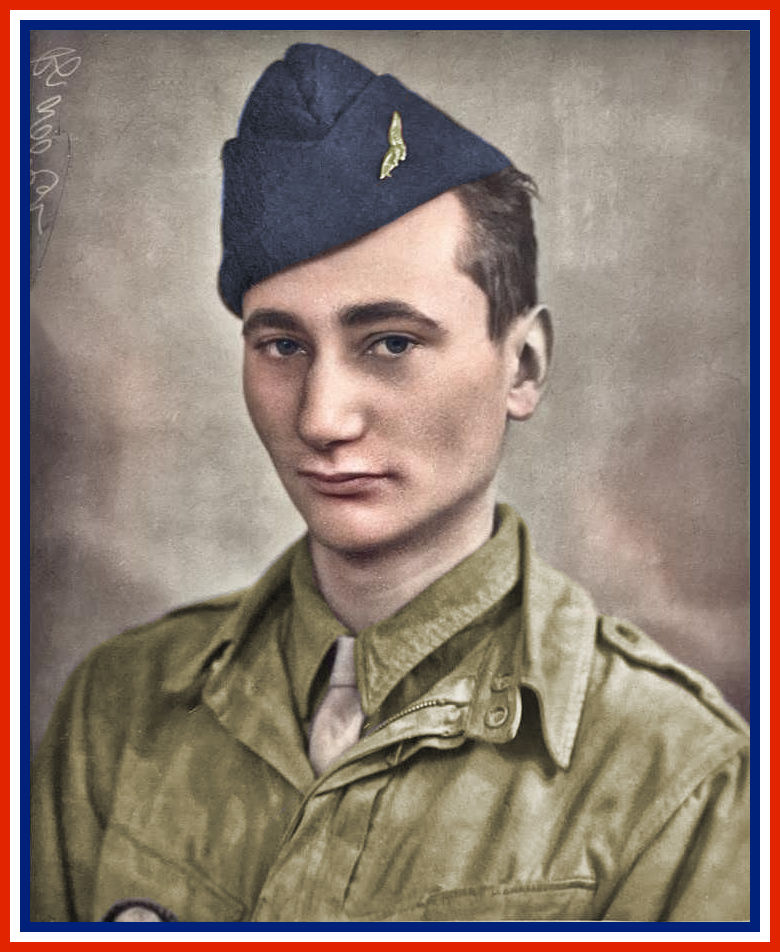
Tribute to Michel Brossolet, Chasseur Parachutiste with the 6th Company of the 1st RCP…a Brave among the Brave!
“A young hunter with quiet courage. On October 16, 1944, during the attack on the Col du Ménil, showed great qualities of coolness and determination while clearing enemy resistance.”
Extract from General Order n°1, Lieutenant-Colonel Faure, Commander of the 1st RCP, citing Michel Brossolet in the Regimental Order and awarding him the Croix de Guerre 1939 – 1945 with bronze star, February 6, 1945.
“Young elite hunter full of drive, remarkable for his great quiet courage and tenacity. On October 6, 1944, at his baptism by fire in the battle of Grettery Wood (88), stood out for his casualness and good-naturedness under particularly deadly enemy sniper fire. On October 16, 1944, during the attack on the Col du Menil(88), he played an effective part in reducing resistance. In these circumstances, against an enemy who was being killed on the spot, demonstrated the finest military qualities through his fighting spirit and absolute disregard for danger. On December 14, 1944, during the attack on the village of Bindernheim(67), carried out several particularly dangerous liaison missions through an area battered by enemy artillery and automatic weapons. His platoon withdrew, voluntarily remaining alone with the wounded under intense artillery fire. Despite the continuing bombardment, he later volunteered on several occasions to fetch the wounded and the body of an officer. On December 15, 1944, north of Neunkirch (67), during a liaison patrol, was seriously wounded by a mine explosion.”
Mentioned on June 14, 1946, with award of the Military Medal and the Croix de Guerre 1939-1945 with palm.
Michel Brossolet was born in Paris on January 3, 1923, and escaped from France on September 26, 1943, with the aim of going directly to North Africa.
Assigned to the French Air Force on January 5, 1944, at the Blida air base in Algeria, until March 20, 1944.
Italian campaign from April 1 to September 3, 1944: He was commissioned in Sicily on May 1, 1944 – brevet 1870.
French campaign from September 5 to December 15, 1944, when he was wounded in a mine explosion (right leg amputation) in Alsace at Neunkirch (67).
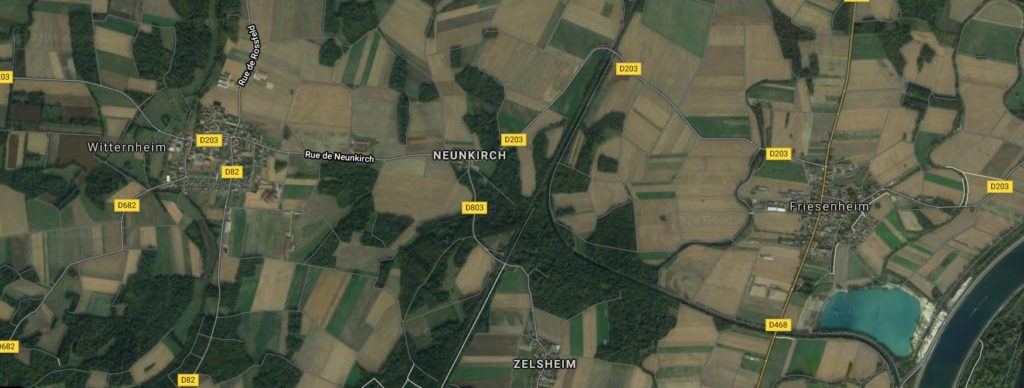
Demobilized on September 12, 1945 with a disability percentage of 95%.
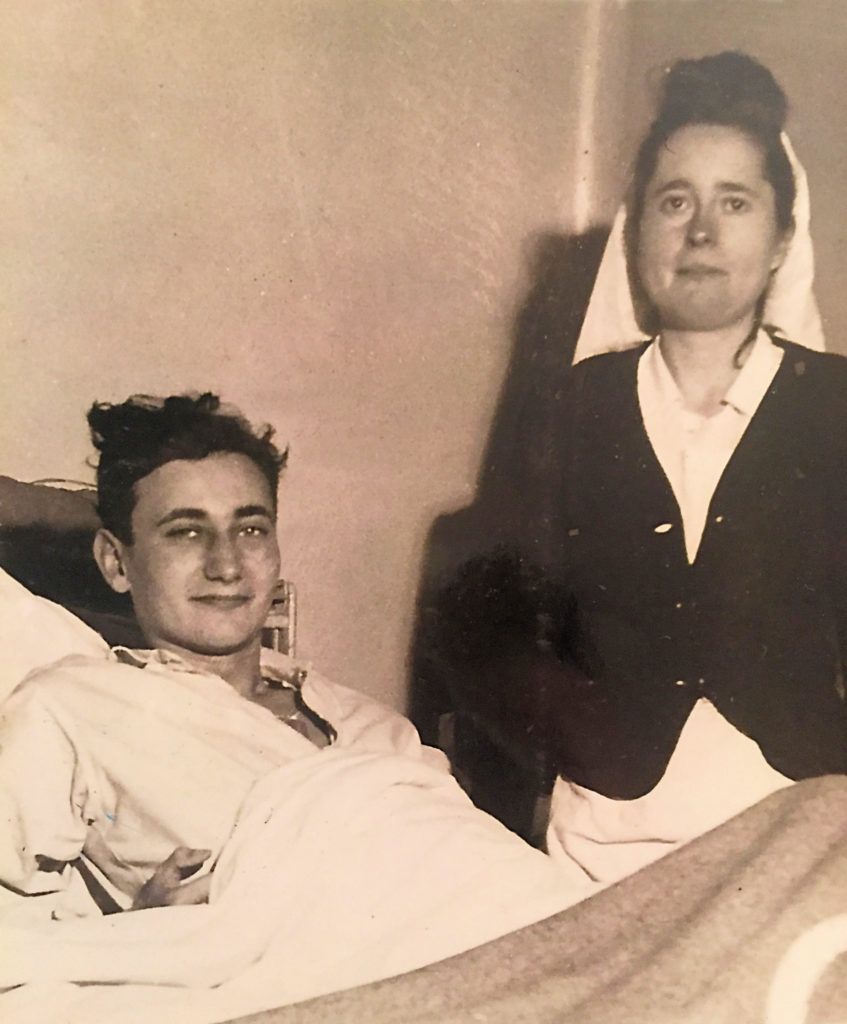
Promoted to Chevalier de la Légion d’honneur by decree of February 25, 1966.
He died in Paris on January 22, 1972.
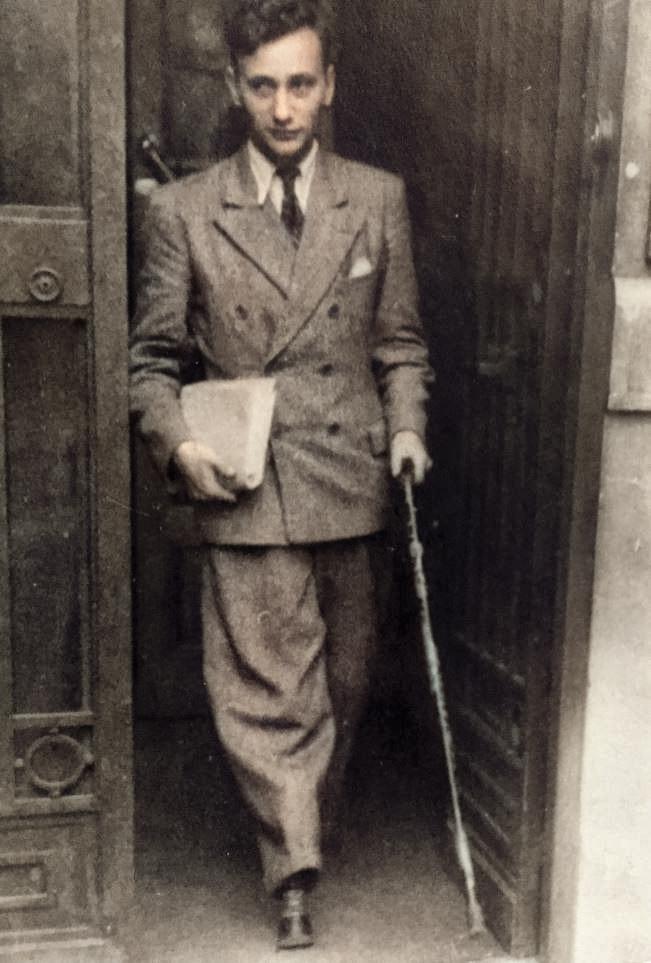
In addition, 97-year-old Lucien Alcat wrote in August 2020: “The day Michel Brossolet was wounded on the Col du Menil (88) in October 1944, I was there as a stretcher-bearer. I can’t remember the names of the guys we stretchered off. Nurse and friend Pierre Berceaux, who was about 4 meters away from me, was amputated. I had gone over to Aspirant Hoarrau, who had received shrapnel in his lungs, slowed down by the down bag on his back. A wounded guy wanted me to take his machine gun, but I couldn’t, so I reported it to someone else. I still remember that day, the forest was full of smoke. I thought I was the only survivor. “
Our warmest thanks go to his family for the photos, and to the traditions of the 1er RCP for their invaluable help, especially Captain DR.
Photos: Brossolet family/mmcpc
CAPM documents and excerpt of the fighting from December 13 to 19, 1944, from Robert Wagener’s history of the 1er RCP.
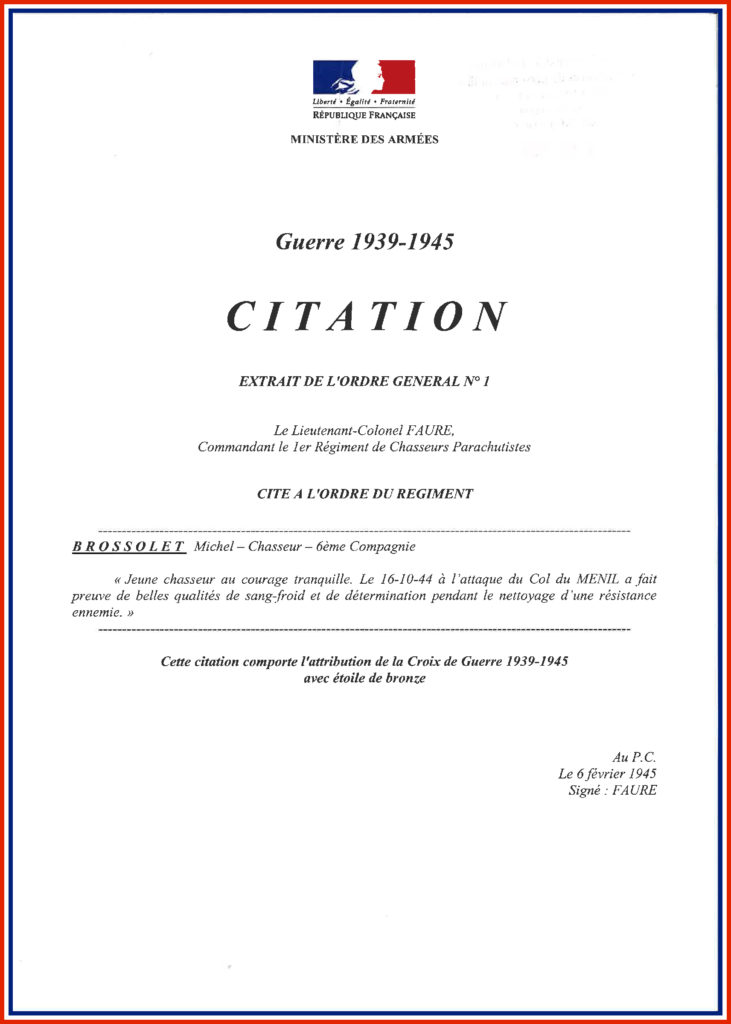
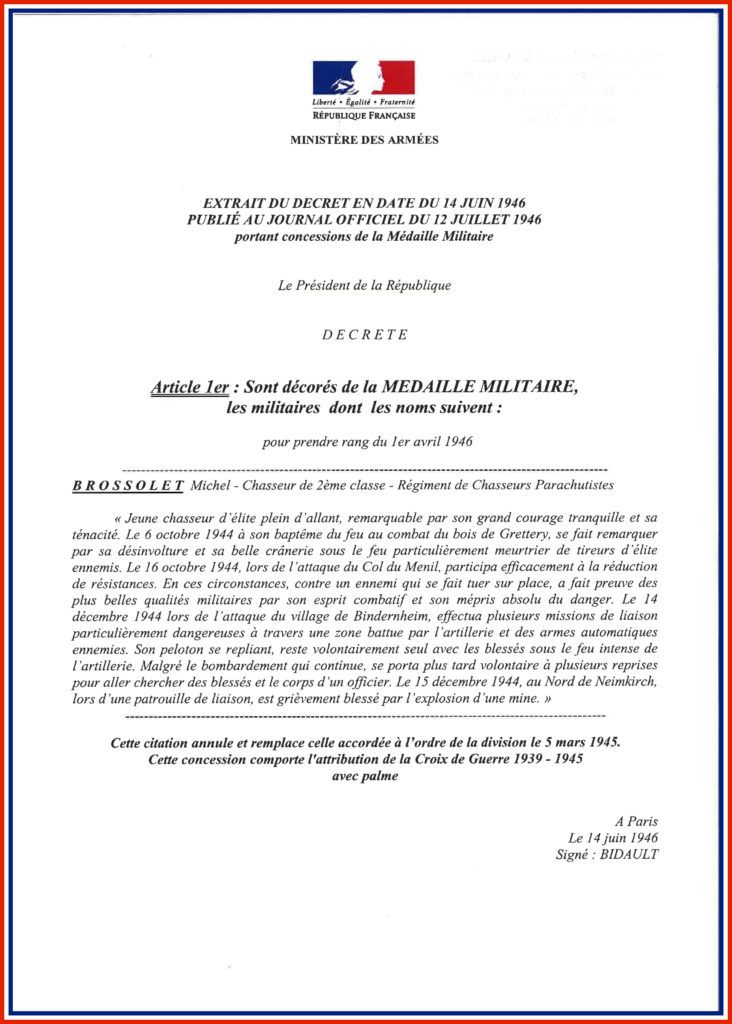
The story of the fighting in the Neunkirch sector in December 1944…
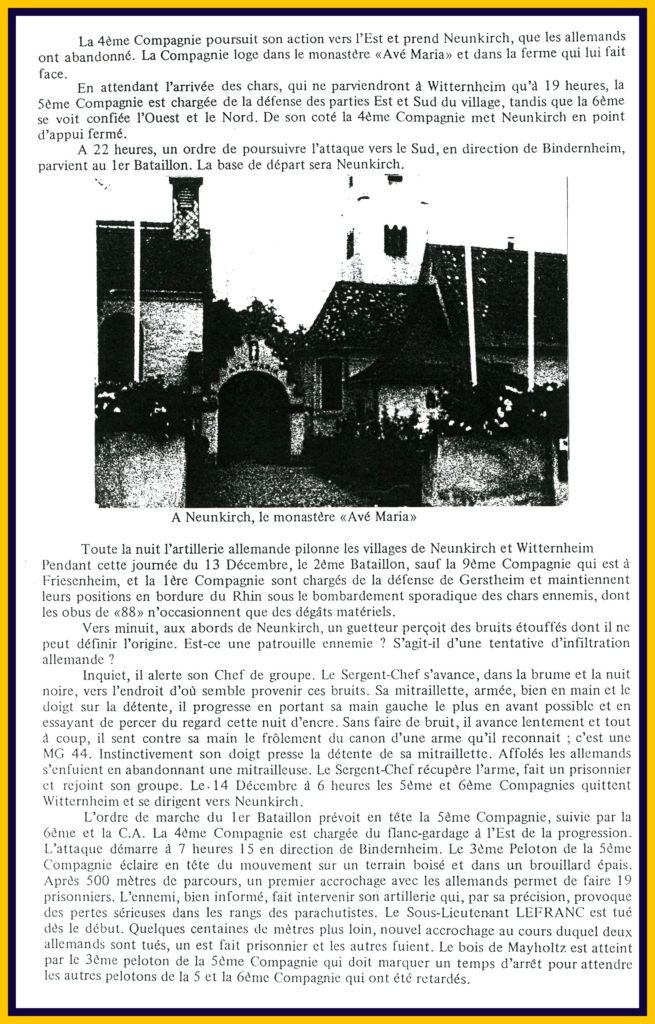
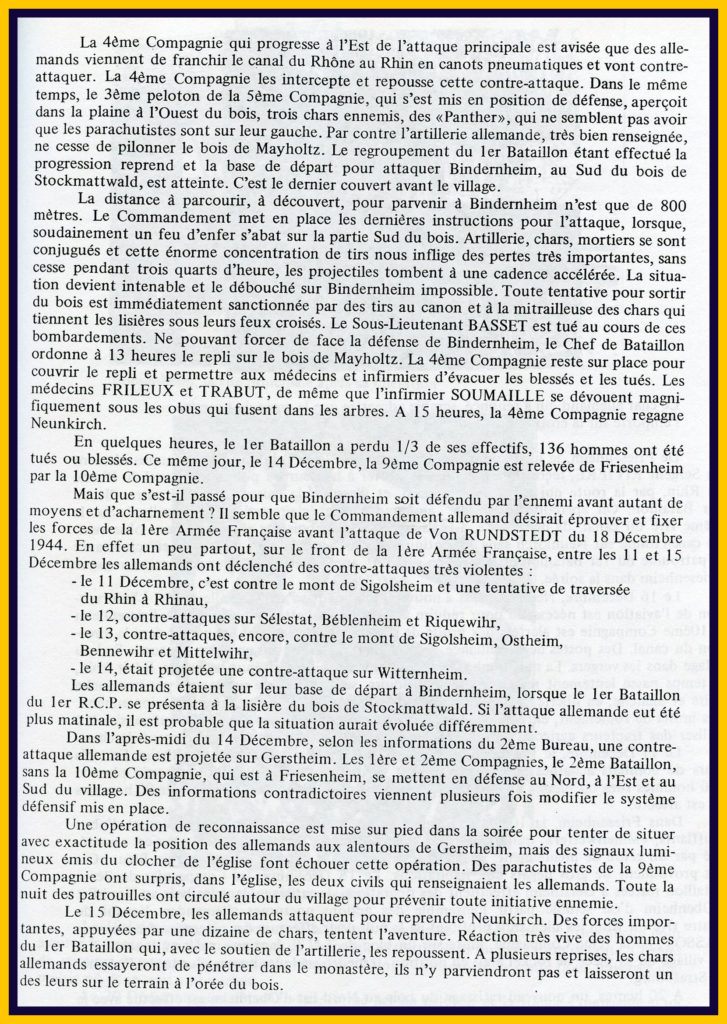
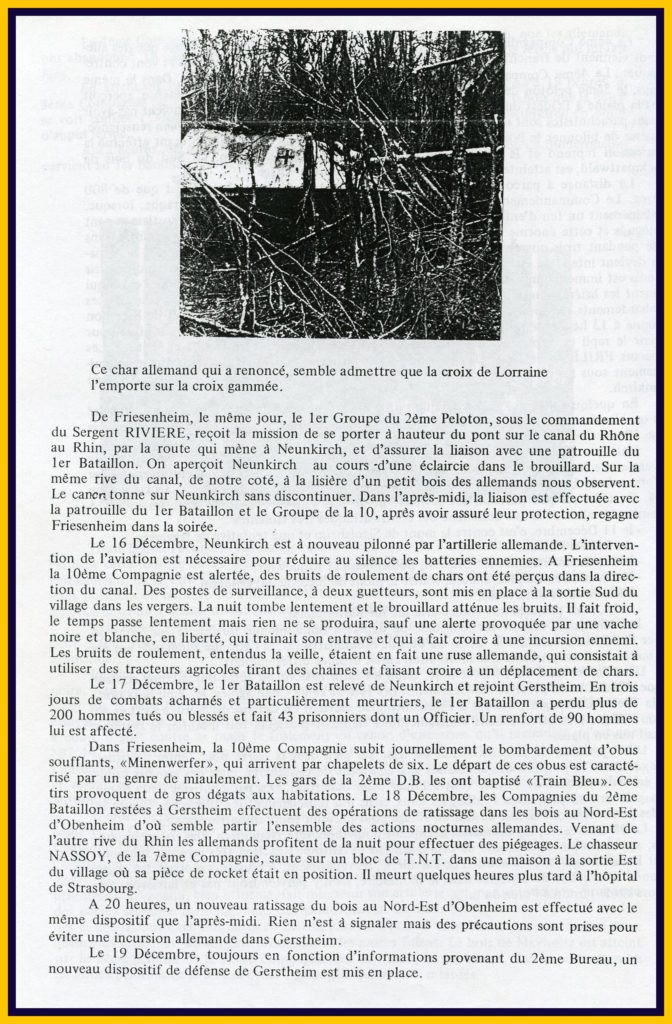
René LOESLE 1915 – 1991
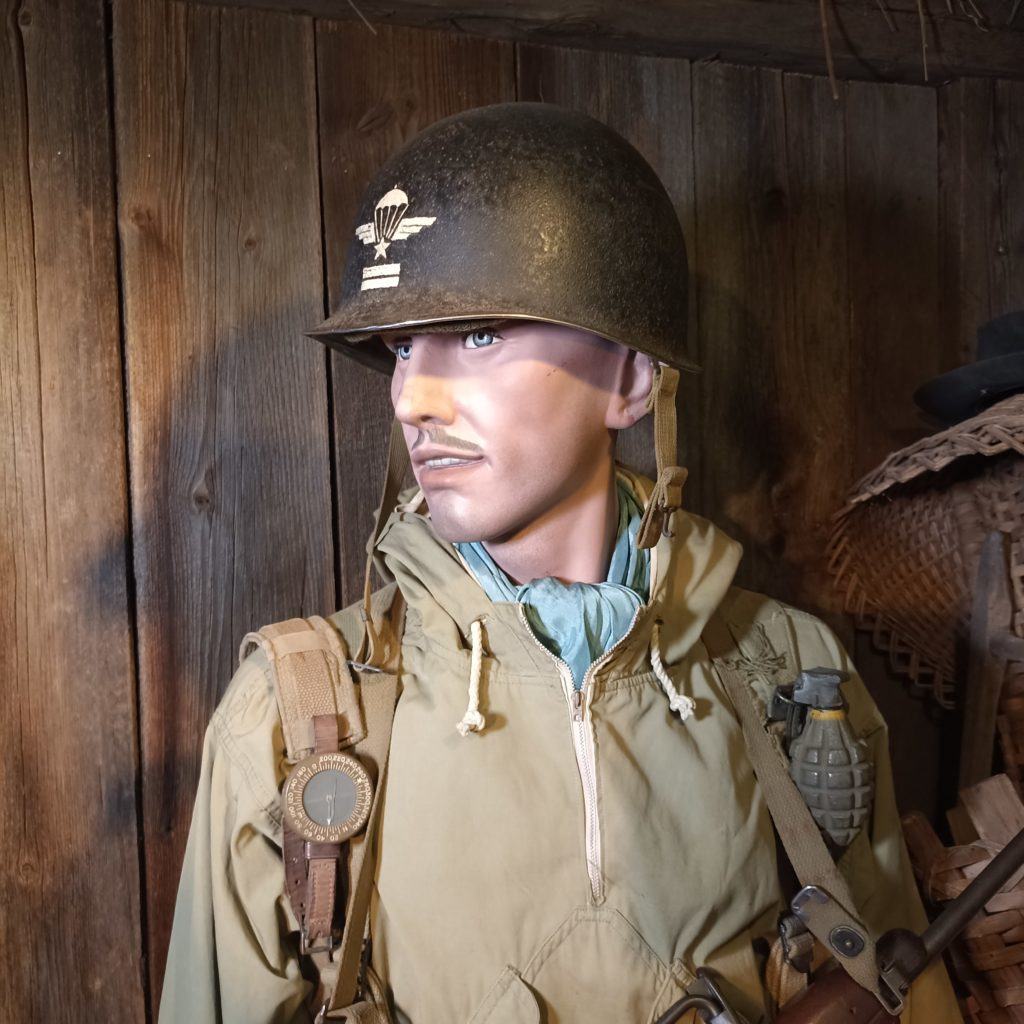
He was born on April 11, 1915 in Paris, son of Ernest and UHL Marie Salomé, residing at 5 rue de la Luss in Colmar.
In 1934, he graduated from the Préparation Militaire Supérieure.
Enlisted by anticipation of call-up on 18/10/35 at the Colmar military quartermaster’s office, with the 152nd Infantry Regiment. At the time of his enlistment, he was a primary school teacher.
He was admitted to the Saint Maixent school on 10/25/1935.
Promoted to reserve second lieutenant on April 10, 1936, he was assigned to the 42nd Fortress Infantry Regiment (42ème RIF), where he completed his casemate training as a student officer and then instructor.
Released from active service and placed on availability on October 1, 1937, he returned to Colmar. He was recalled to active duty on September 20, 1938 in the 42nd RIF and promoted to reserve lieutenant. He was sent home on December 4, 1938.
Recalled to active service with the 42nd RIF on 16/8/1939, he was transferred to the n°74 infantry depot in Langres on 9/9/1939 before being admitted to the aircraft observer training course at Base 109 in Tours on 02/15/1940. Transferred to Pau Air Base on 6/21/1940, posted to the 4th Cie in Bornes on 8/23/1940, then to the 152nd Rifle Cie in Pau on 9/5/1940, where he was demobilized on 11/16/1940.
Remobilized at his own request to the Guadeloupe Cie on 11/22/1943 in Basse-Terre on 11/22/1943, then St Pierre (Martinique) he was transferred to the BICM in Fort-de-France where he embarked on the ss’ “Oregon” on 12/3/44 and disembarked in Casablanca on 3/30/1944 to move to Algiers on 7/9/1944.
He crossed the Algerian-Moroccan border on 11/7/1944 and joined the 1 RCP on 16/07/1944, at the isolated depot in Baraki on 22/07/1944. He embarked in Algiers on 07/29/1944 for the Italian theater of operations. He landed in Naples on August 4/1944 and arrived at the 1st Cie of the 1 RCP in Rome on August 8/1944.
He was seconded to the Airborne Training Center, supervised by the American paratroopers of the 82nd Airborne, from 13/8/44 to 2/9/44. He was awarded the Brevet parachutiste de l’infanterie de l’air n°2081 on 1/9/1944. He was posted to the 7th Cie of the 1 RCP as assistant to the Cie commander on 3/09/1944.
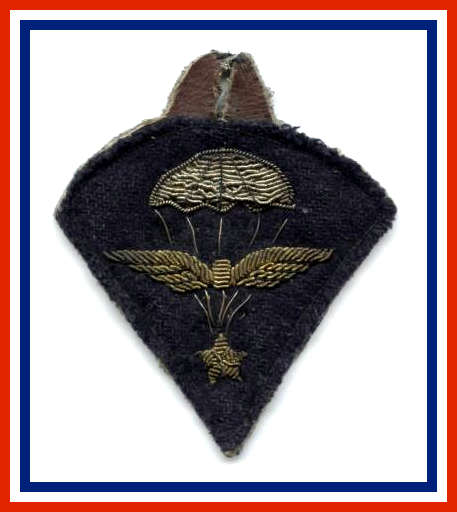
He took part in the Vosges campaign from 3/10/1944 to 24/10/1944 and the Alsace campaign from 8/12/1944 to 19/2/1945.
He was wounded in the jaw by shrapnel on 10/16/1944 at Col du Ménil in the Vosges.
For his action, he was cited in the Division Order by Brigadier General Sudre, commander of the 1st Armored Division:
“Assistant company officer, showing remarkable calm and composure in all circumstances. Never ceased to actively assist his unit commander during operations from October 3 to 24, 1944. Successfully carried out several patrols in the Gehan forest, particularly at hill 1011. Wounded at the Col du Ménil pass on October 16, refused to be evacuated.”
This citation includes the Croix de Guerre 1939-1945 with silver star.
He took part in the Alsace campaign from 8/12/1944 to 19/2/1945.
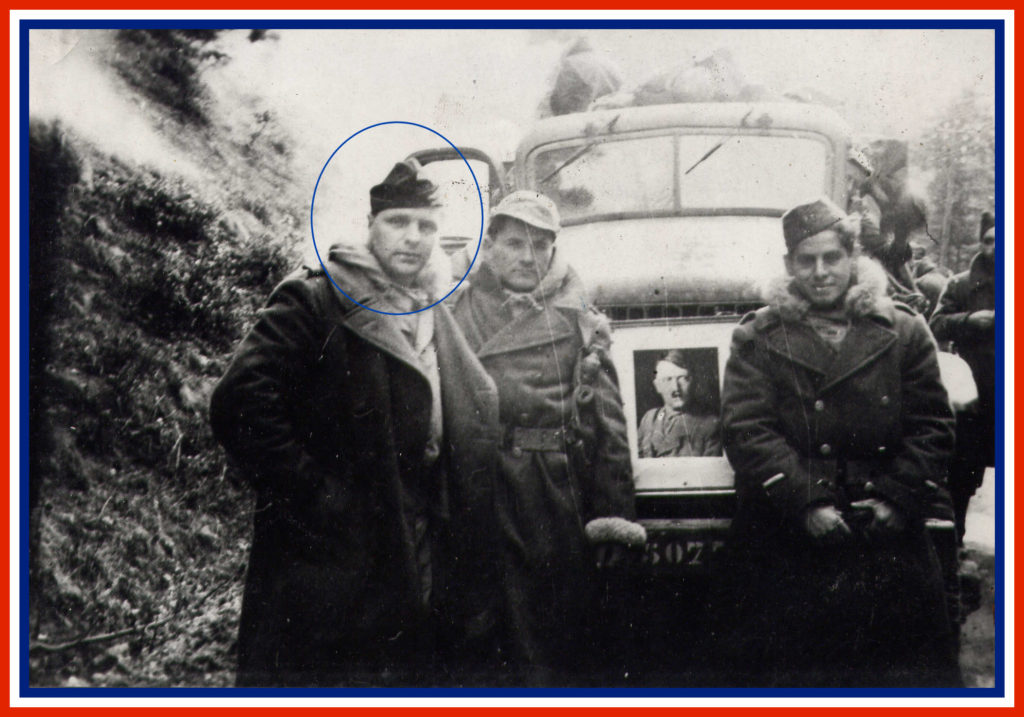
Released to the Army (24°DAP) on 1/8/45 (AM.1285/SPMM/A dated 16/10/45 from the Minister of Air).
He was demobilized on 01/30/1946 and struck off the army rolls.
He married Jeanne Kaltenbach in Colmar on November 25, 1949.
Promoted to reserve captain on 12/1/1950, then to commander on 10/1/1959. Promoted to reserve lieutenant-colonel on 1/10/1969.
Chevalier de la Légion d’Honneur.
Croix de Guerre 1939-1945 with silver star.
Croix du combattant Volontaire 1939-1945.
He died in Colmar on June 7, 1991.

Let us remember him and his comrades.
Jean VINCENT 1921 – 1982
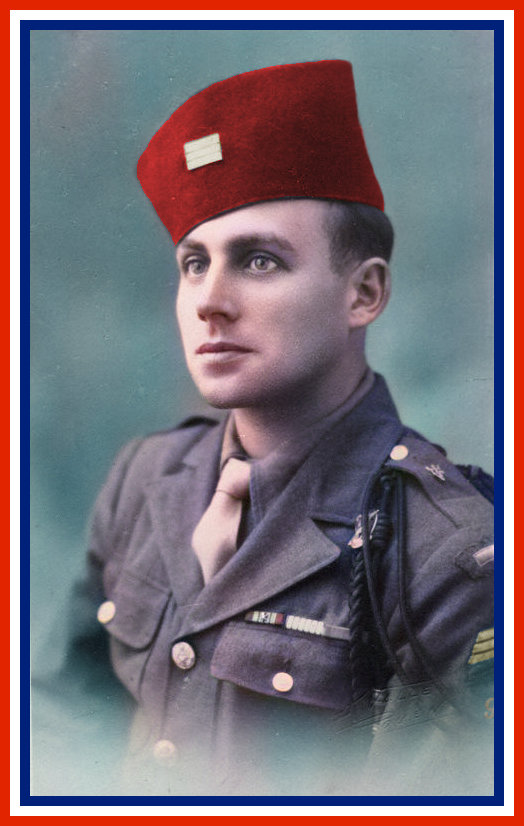
Tribute to Jean VINCENT and his comrades of the 9th Zouaves Regiment…
Jean VINCENT was born in Dieppe on June 9, 1921. He was a confectioner when war broke out, and like many of his French compatriots, he wanted to defend his country, as his father had done in the First World War, when he was gassed in the trenches and crippled for the rest of his life.
He decided to fight Nazism, whatever the cost, whatever the means.
Since leaving France for England was no longer possible with the occupation of the coastline, he chose to cross France to Spain in the company of one of his aunts, a member of the Resistance, who accompanied him all the way to the Spanish border, without Jean Henri’s parents knowing, so as not to worry them further with his plans to continue the struggle and join a fighting unit.
Once in Spain, we know very little about him, because despite his son’s insistent and repeated questions after the war, he never wanted to answer them, because “he had only done what he had to do”… we can guess from his service record the rest of his military career.

Provisional voluntary enlistment for 3 years on 10.04.1941 with the 1st Zouaves Regiment under regimental number 9485 (definitive contract on 23.04.1941).
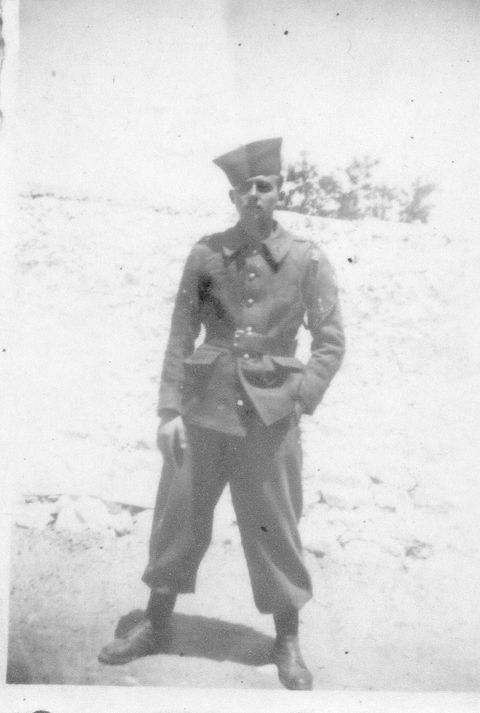
Arrived at the corps and incorporated on 24.05.1941. Appointed corporal on 10.04.1941, then master corporal on 01.01.1943.
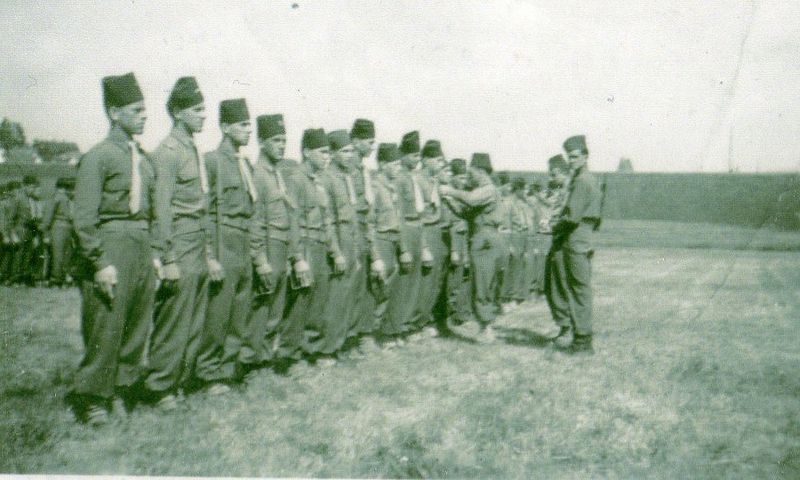
On February 1, 1943 he was assigned to the 9th RMTZ (Régiment Mixte de Tirailleurs et Zouaves).
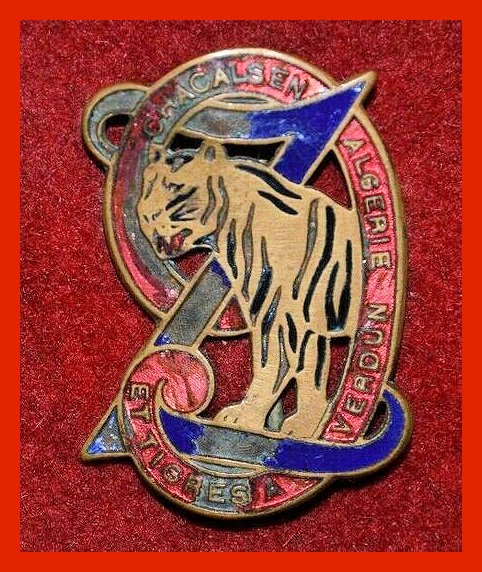
Appointed sergeant on 01.06.1943 by regimental order no. 4 of 8.5.43.
On 08.06.1943 he moved with the Battalion towards Tunisia, crossing the Algerian-Tunisian border on 26.07.1943. He then moved with the Battalion towards Algeria on 22.10.1943 and crossed the Tunisian-Algerian border on 23.10.1943.
He embarked in Algiers on 18.11.1943 aboard the steamer “Marrakech”, landing in Ajaccio on 21.11.1943.
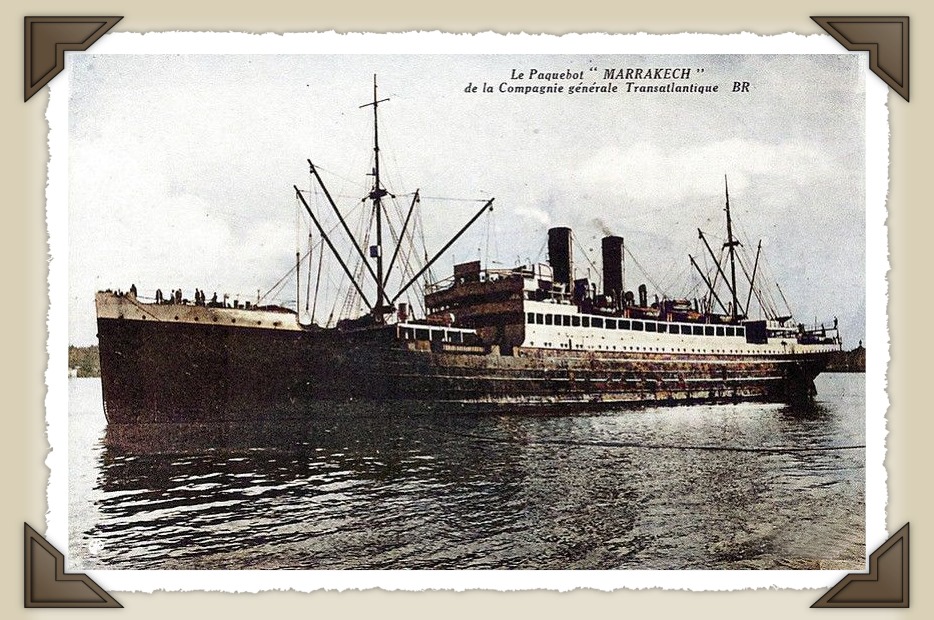
His contract expired on 10.04.1944 and was tacitly extended from 11.04.1943 in compliance with NDS n°46 MAG/CAB of 09.01.1943.
He embarked at Ajaccio on 16.06.1944 and landed in Italy on 17.06.1944.
From 18.06.1944 he was in occupation at Pianosa (an island near Elba), re-embarked on 03.07.1944 and landed at Bastia on 04/07/1944.
Joins the unit. Embarked at Calvi on 09/11/1944 and landed at Saint-Raphaël on 09/12/1944.
Appointed Staff Sergeant on 01.12.1944.
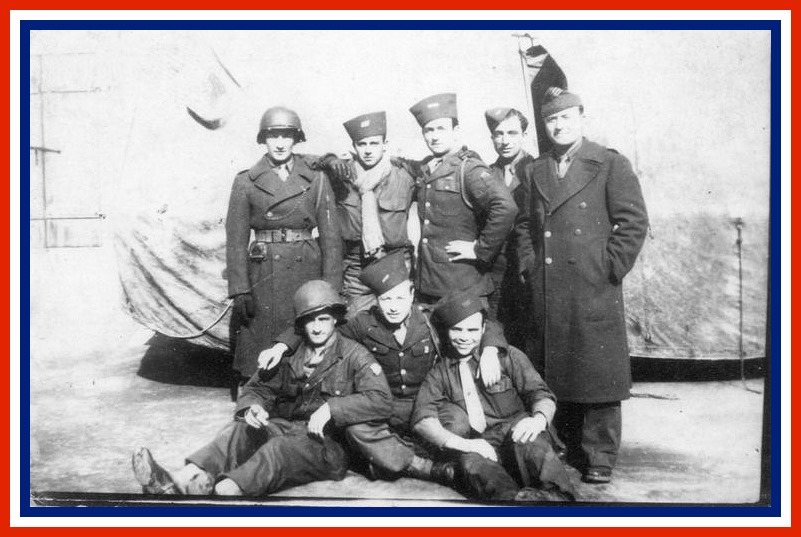
By regimental order no. 40 dated 11.12.1944, directed to the front on 13.11.1944.
Assigned CAC (Commando) by AM n°136/1594/CL dated 18.11.1945.
Crossed the Franco-German border on 28.03.1945, returned to France and crossed the German-French border again on 15.08.1945.
Demobilized and sent home on 10.31.1945 by the demobilizing body of the 9th Zouaves Regiment.

He retired to Bois-Guillaume in the lower Seine.
Joined the 1st reserve on 01.11.1945, attached to the PJ2R mobilization class as father of 3 children (article 58 of the law of 31.03.1927).
After demobilization and his return to civilian life, he worked in a large garage in Rouen as a truck driver. For the record, his tow truck “mount” was a Ward La France Wrecker M1A1 from the US Army, which he used until his retirement in 1981. Unfortunately, he didn’t enjoy his retirement for long, as he died 1 year later, on April 18, 1982 in Bois-guillaume (76).
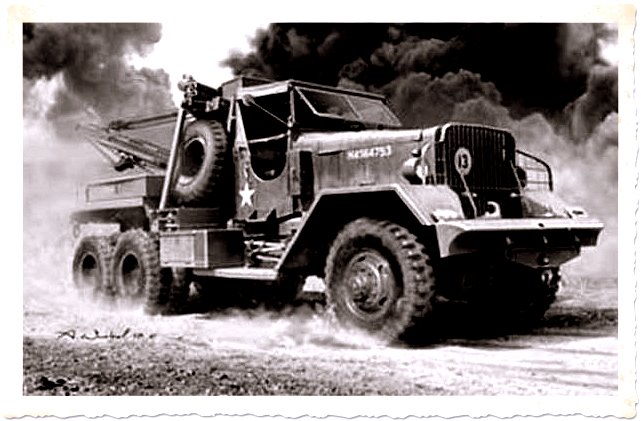
Our warmest thanks go to his son Jean-Luc, one of our loyal readers, and also to his aunt Jeanne Vincent and his grandparents, who told him about his father’s journey when he was a child, for sharing their precious photos and family documents, enabling us to pay him the tribute he deserves.
Through this portrait, we also pay tribute to all his comrades in the 9th Zouaves who fought to liberate France, and to those who never came back, making the ultimate sacrifice of their lives so that today we can live in freedom. Let us never forget them!
Jean de LATTRE de TASSIGNY 1889 – 1952
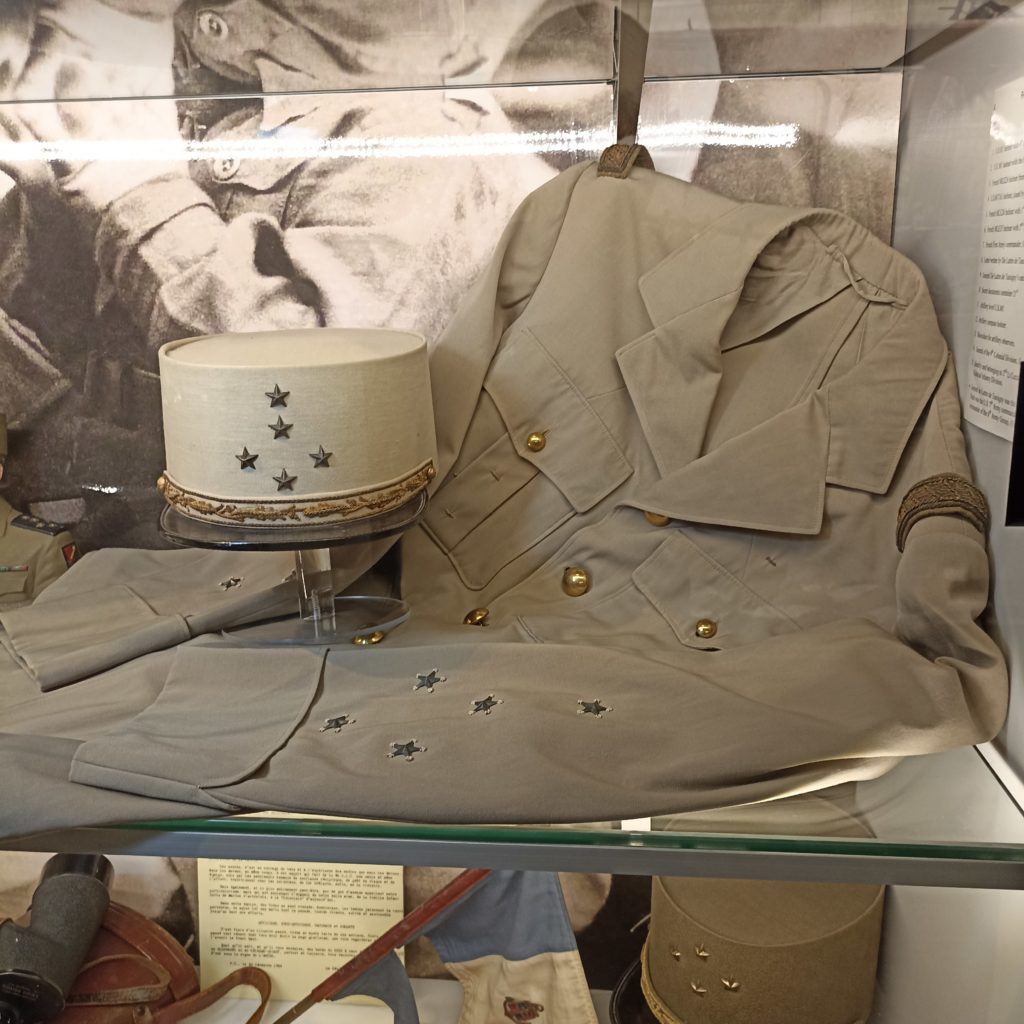
JEAN DE LATTRE DE TASSIGNY: a servant of FRANCE.
He was born on February 2, 1889 in Mouilleron-en-Pareds, the small Vendée village where Georges Clémenceau was born half a century earlier.
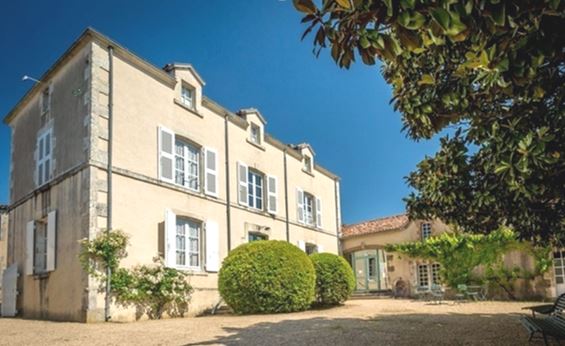
He entered Saint-Cyr (“Mauritania” class, 1909-1911), served in the cavalry and joined the 12th Dragons at Pont-à-Mousson.
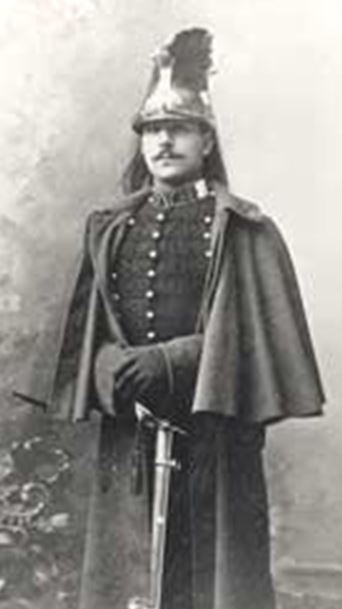
It was in Lorraine that he began the 1st World War, and from the outset made a name for himself by his bravery.
A scout officer in the 2nd Cavalry Division, Lieutenant de Lattre was wounded twice in the early months of the 1914-1918 war, by shrapnel in August and a lance wound to the chest in September. On December 20, 1914, he was made a Knight of the Legion of Honor.
Volunteering for the infantry in 1916, he joined the 93rd Infantry Regiment, the Vendée Regiment and fought at Verdun, where he spent several months, and on the Chemin des Dames. He ended the war as a captain, wounded 5 times and cited 8 times.
In 1919, he was assigned to the XVIIIth Region Headquarters in Bordeaux. He was then appointed to the Franco-American section, where he was in charge of relations with the troops of the American General Pershing, pending their return to the United States.
He then served in Morocco (1921-1926) under the command of Lyautey, a personality who left a deep impression on him. He took part in the Haute Moulouya operation in 1922 and the Taza operation in 1923. He was chief of staff for the Taza region during the uprising led by Abd el-Krim against the French (Rif war, 1925-1926). Wounded again (2x) and cited 3 times, he was promoted to battalion commander in 1926.
In 1927, he entered the Ecole de Guerre and married Simonne Calary de Lamazière, more than 17 years his junior; a son, Bernard, was born in 1928.

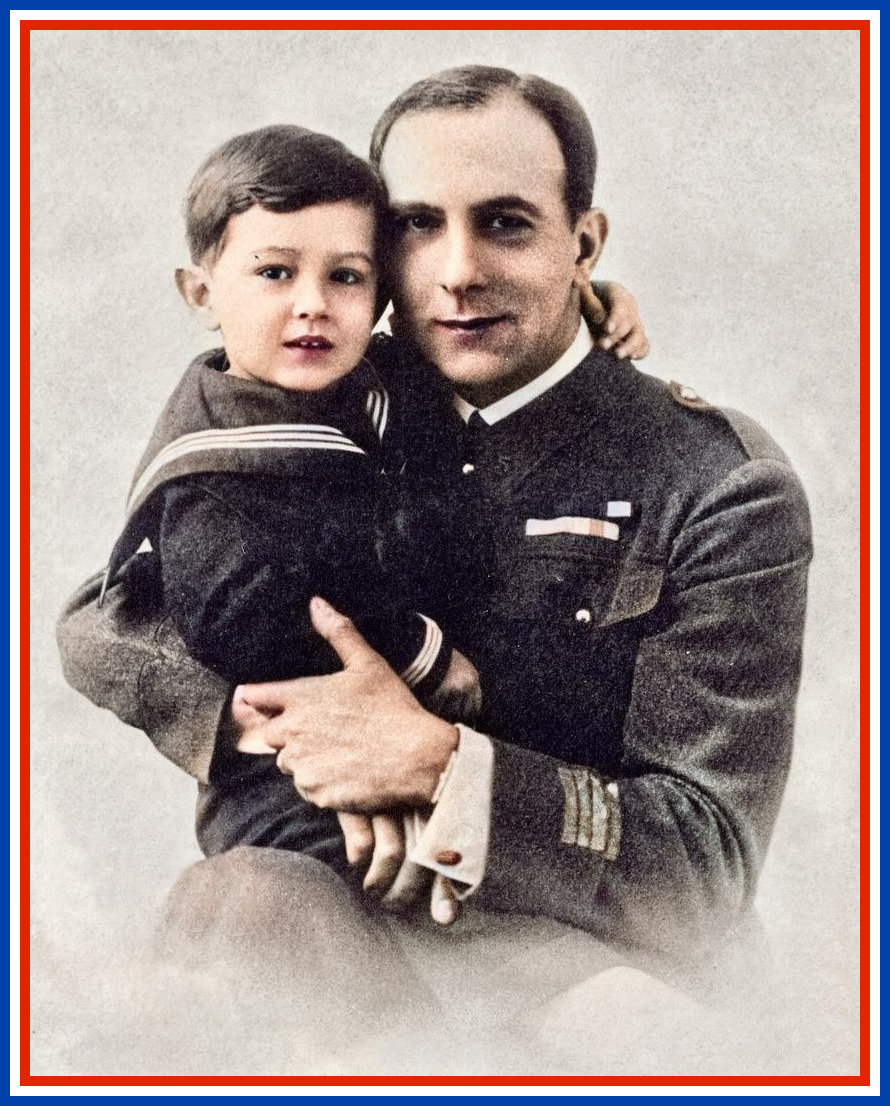
On July 2, 1929, Jean de Lattre graduated as valedictorian of the 49th class of the Ecole Supérieure de Guerre.
In 1932, he joined the staff of General Weygand, then Vice-President of the Conseil Supérieur de la Guerre. In charge of “Planning” and “Foreign Relations”, Lieutenant-Colonel de Lattre kept abreast of developments in foreign policy during his three years with General Weygand and then General Georges.
Promoted to colonel in 1935, he took command of the 151st Infantry Regiment in Metz, whose military governor was General Henri Giraud, whom he had known and liked in Morocco.
In 1938, he was a student at the Centre des Hautes Etudes Militaires (CHEM). His appointment to the rank of brigadier general in March 1939 made him the youngest general in France; chief of staff of the 5th Army – the “Armée d’Alsace”.
On January 1, 1940, he took command of the 14th Infantry Division.
In June 1940, he fought victoriously at Rethel at the head of his Division, the “Division des As”, whose motto he adopted: “NE PAS SUBIR” (DO NOT SUBMIT), where it repulsed German troops three times as they attempted to cross the Aisne, before withdrawing to the Marne and Loire rivers, where fighting was delayed.
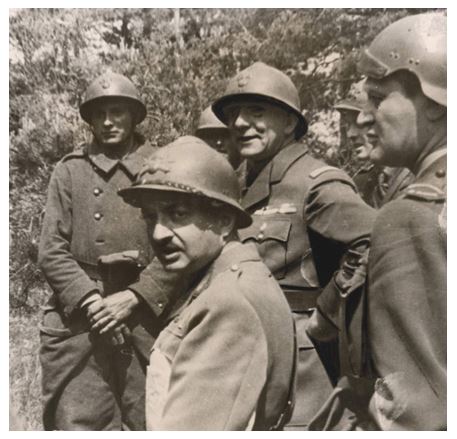
After Rethel, General de Lattre, who had been ordered to withdraw, kept his Division together, fighting and taking prisoners until the armistice on June 22, 1940.
In Clermont-Ferrand in July, when the 14th Division was disbanded, he told his men: “We’ve been beaten, but one day we’ll fight again. I’ll see you then. A few days later, he repeated this pledge to a group of officers at Opme castle: it was the “Opme oath”; he began to hide weapons and set up the Opme Cadre School to restore hope to a lost youth.
Appointed Major General and Commander of the Tunisian troops in 1941, he was recalled to mainland France in 1942. He was then appointed Lieutenant General and Commander of the Montpellier Division. At the time of the Allied landings in North Africa in November 1942, he tried in vain to lead his soldiers into dissidence in anticipation of an Allied landing, and to fight the Germans who had invaded the so-called “free” zone.
On November 11, 1942, when the Germans entered the free zone, he ordered his troops to leave their garrisons and resist. Arrested, he was incarcerated at the Maison centrale d’arrêt de Toulouse, then at Fort Montluc in Lyon, and sentenced on January 9, 1943 to ten years’ imprisonment for abandoning his post by the Tribunal d’État (a special court with no right of appeal). On February 2, he was transferred to Riom, from where he escaped on the night of September 2 to 3, with the help of his wife and son, Bernard.
Leaving the Auvergne, where he had been in hiding for a month, he reached the Mâcon region and reached London in mid-October, then Algiers, now the capital of Free France (December 20, 1943).
General Giraud, then commander-in-chief of French forces in North Africa, put him in charge of the Armée d’Afrique, which was to become the Armée B, the future First French Army.
In June 1944, he took Elba. On August 15, 1944, the army from Africa and Italy landed in Provence alongside American troops (Operation Dragoon). Its mission was to seize Toulon and Marseille.
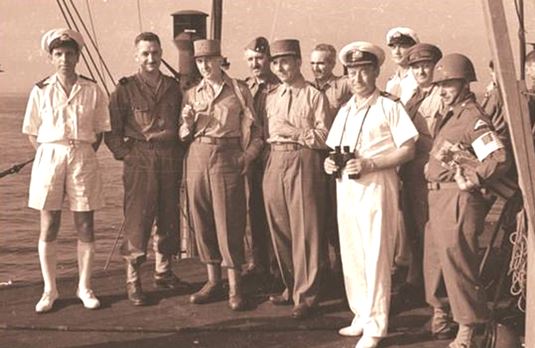
After regrouping the 4 divisions of the French Expeditionary Corps (which, under General Juin, had covered themselves in glory) under his command, de Lattre was at the head of 250,000 men: 2 armored divisions, 5 infantry divisions and non-divisional elements.
On September 11, Army B liberated Toulon and Marseille, moved up the Rhone valley and entered Lyon and Dijon.
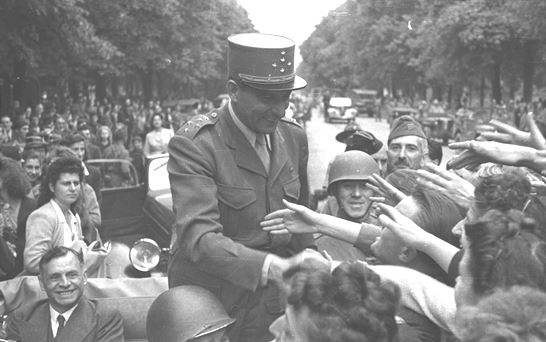
On September 25, 1944, after the capture of Besançon, the 400,000-strong Armée B was amalgamated (from the Armée d’Afrique with the Forces françaises de l’intérieur = the integration of Resistance units into the “regular” army) to become the Première Armée Française.
After fierce fighting in the Vosges, the arrival at the Rhine, the liberation of Mulhouse (11/21/1944) and Belfort (11/20/1944), the First French Army liberated Colmar on February 2, 1945, and definitively reduced the Colmar pocket (February 9, 1945) with reinforcements directly under the command of General de Lattre, General Leclerc’s 2nd DB and, unprecedented in American history, 125,000 American soldiers.
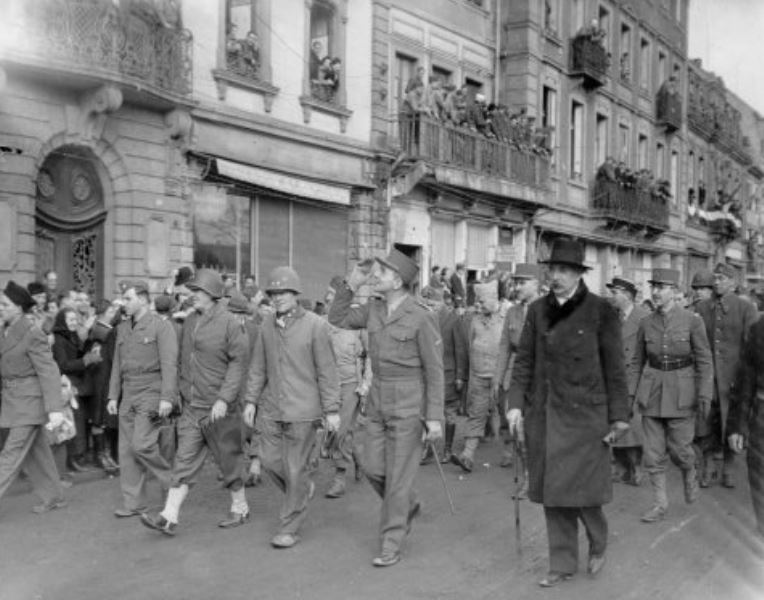
From March 31, 1945, the First French Army crossed the Rhine and, after hard fighting, reached Karlsruhe and Stuttgart, crossed the Danube and pushed on to Ulm, while other elements followed the Swiss border from Basel to Constance, as far as the Arlberg Pass (May 8, 1945).
On May 9, 1945, in Berlin, General de Lattre signed the surrender of Nazi Germany on behalf of France, alongside the Allied leaders.
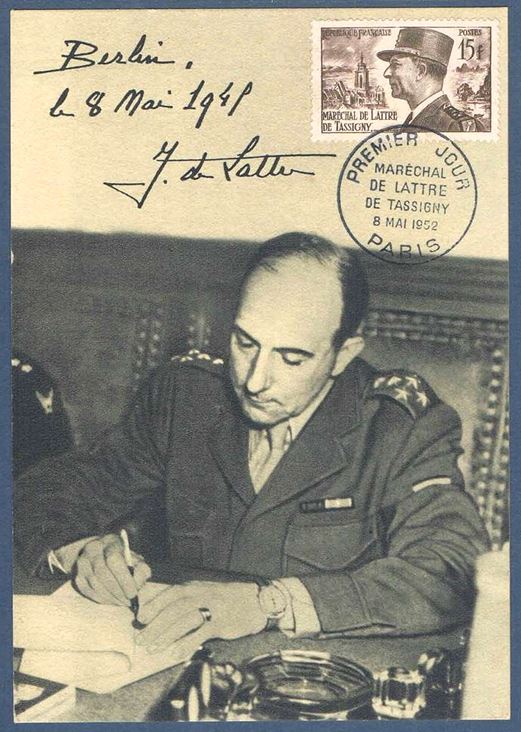
Chief of the General Staff and Inspector General of the French Army (1945-1946), in 1948 he became the first commander of Western European land forces.
In December 1950, he was appointed High Commissioner and Commander-in-Chief of the French Union forces in Indochina, where the situation was desperate. In just a few months, he achieved a spectacular turnaround. His son Bernard, a young officer of 23, was killed on the Ninh-Binh rock in Tonkin on May 30, 1951.
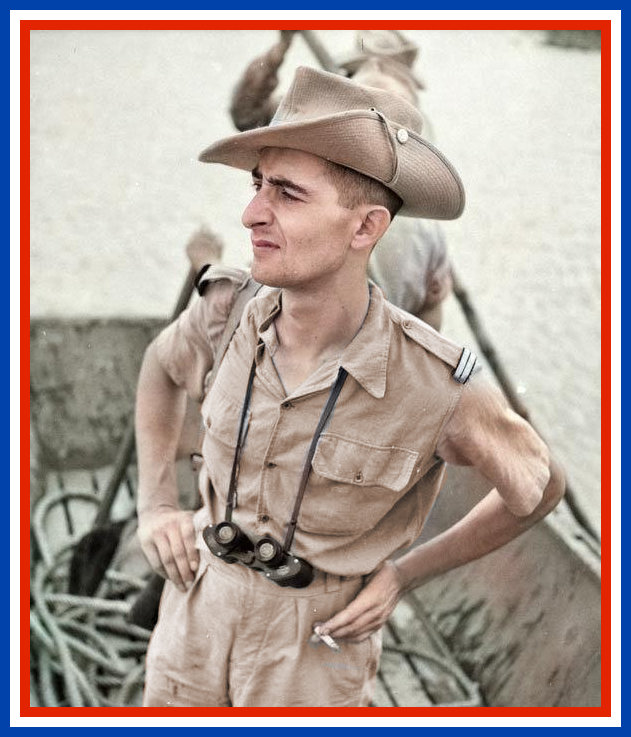
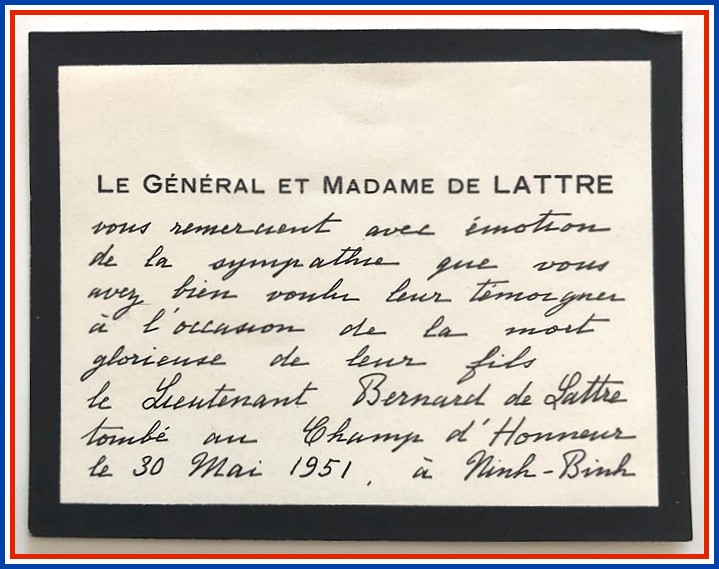
Overcome by grief and cancer, General de Lattre died on January 11, 1952. He was posthumously made Marshal of France.
He was Grand Cross of the Legion of Honor, Companion of the Liberation and holder of the Military Medal, the Croix de guerre 1914-1918, the Croix de guerre 1939-1945, the Croix de guerre des théâtres d’opérations extérieurs, the Médaille des évadés and numerous foreign decorations.
After the national funeral at Notre-Dame de Paris, he was buried alongside his son in the small cemetery at Mouilleron-en-Pareds.
Among the messages left by Jean de Lattre de Tassigny, two stand out:
" Don't put up with it", his motto!“Before dealing with young people, we must understand and love them”.
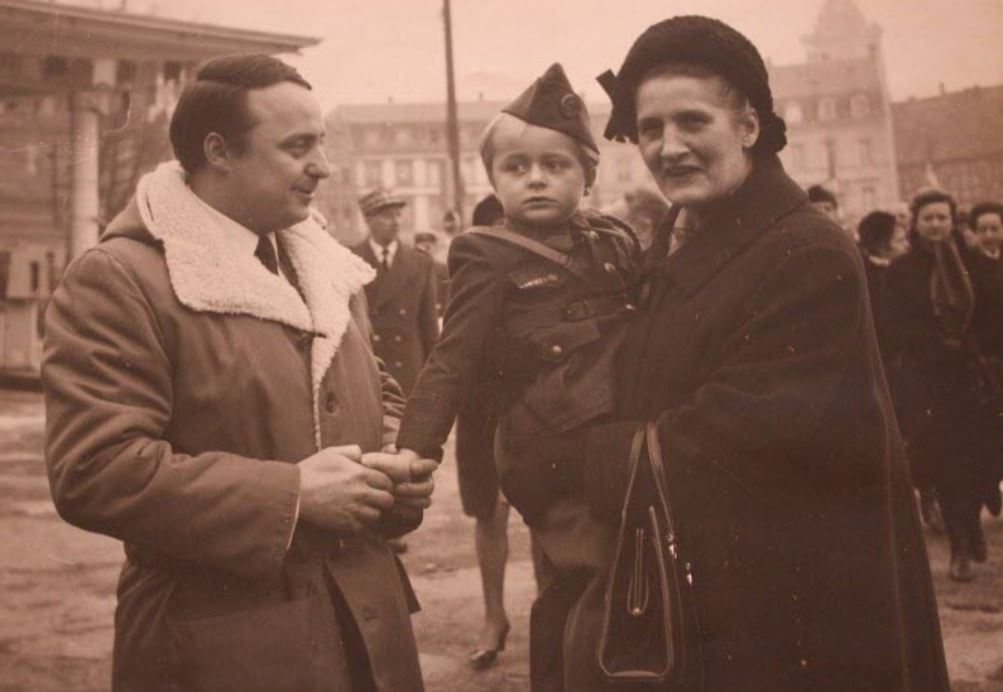
Our thanks to Madame Cornu of the Fondation du Maréchal de Lattre for her invaluable help in sharing the above information.
Canopy Republic P-47D Thunderbolt “Bubbletop”.
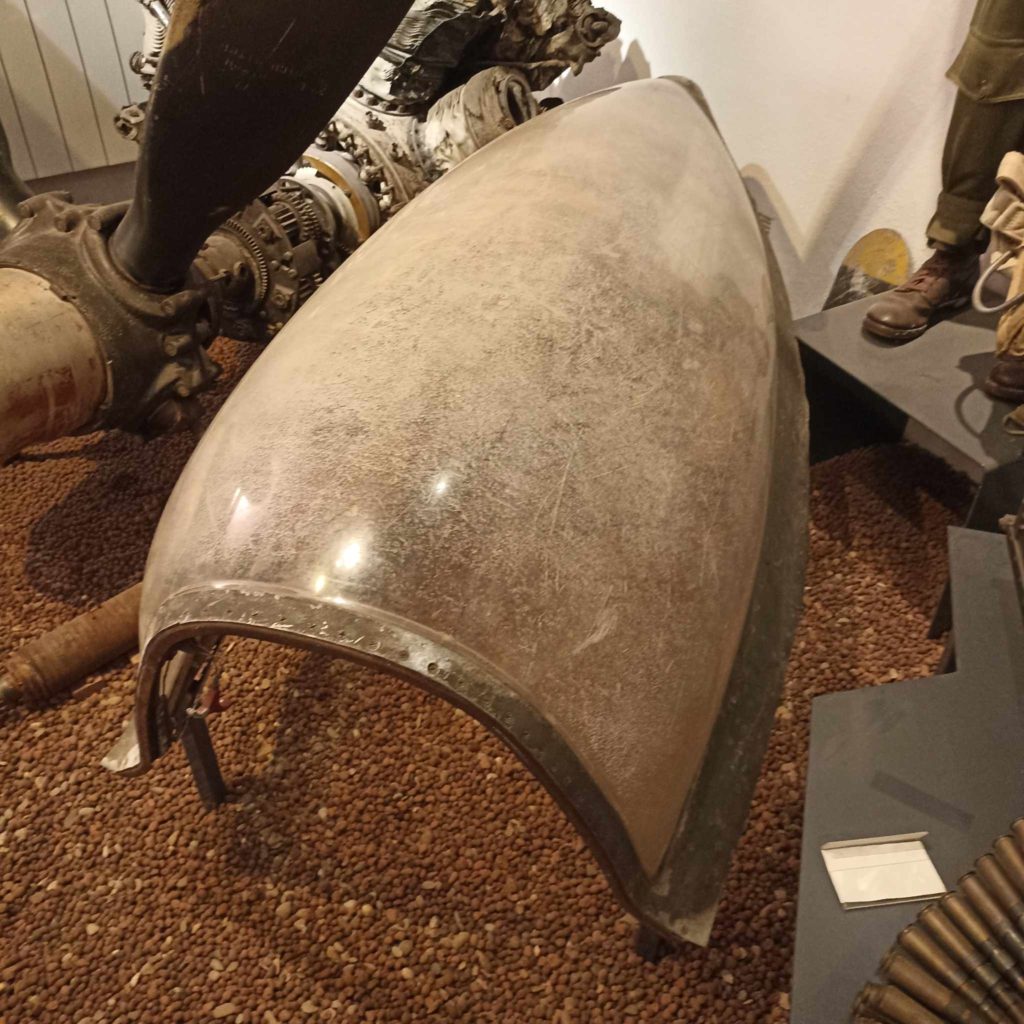
Plexiglas “canopy” of a P-47D Thunderbolt fighter-bomber recovered in 2004 in the Colmar area (68).
Below is a photo of the P47D serial number 44-20-938 of the 2nd squadron of the French Groupe de Chasse GC II/3 “Dauphiné” in flight, clearly showing the “Bubbletop” canopy.
From June 13, 1944 to May 1, 1945, the GC II/3 “Dauphiné” flew 388 wartime missions, representing 3,564 sorties and 6,348 flying hours.
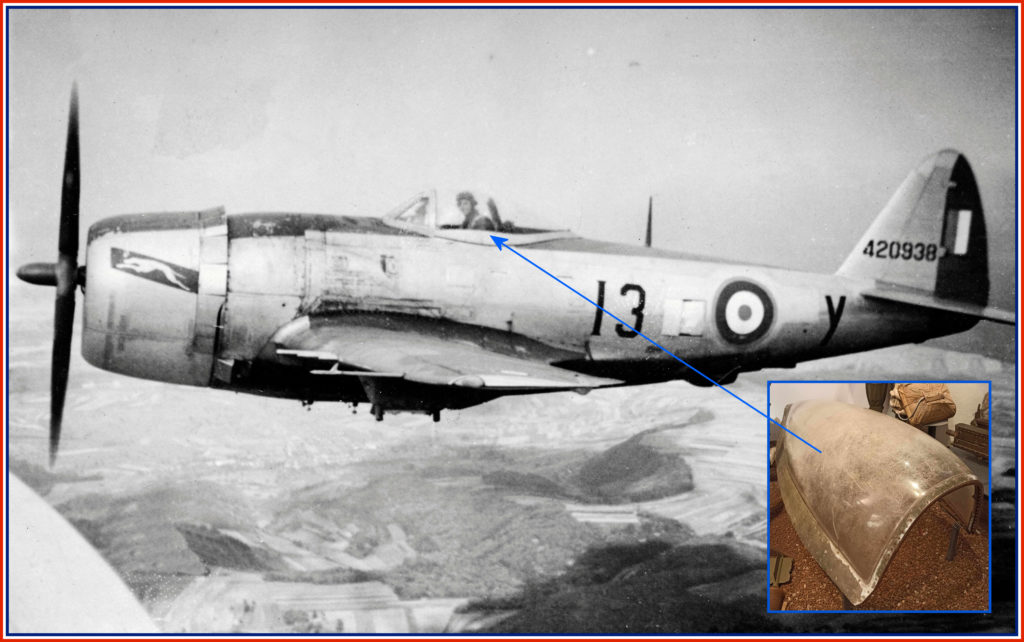
Close-up of the “bubble canopy” of P-47D-27-RE serial number 42-27295, carrying Second Lieutenant Roger Guillaume (1920-2006) of GC II/5 “Lafayette”, who was hit by German Flak during the attack on a train at Colmar station on November 20, 1944.
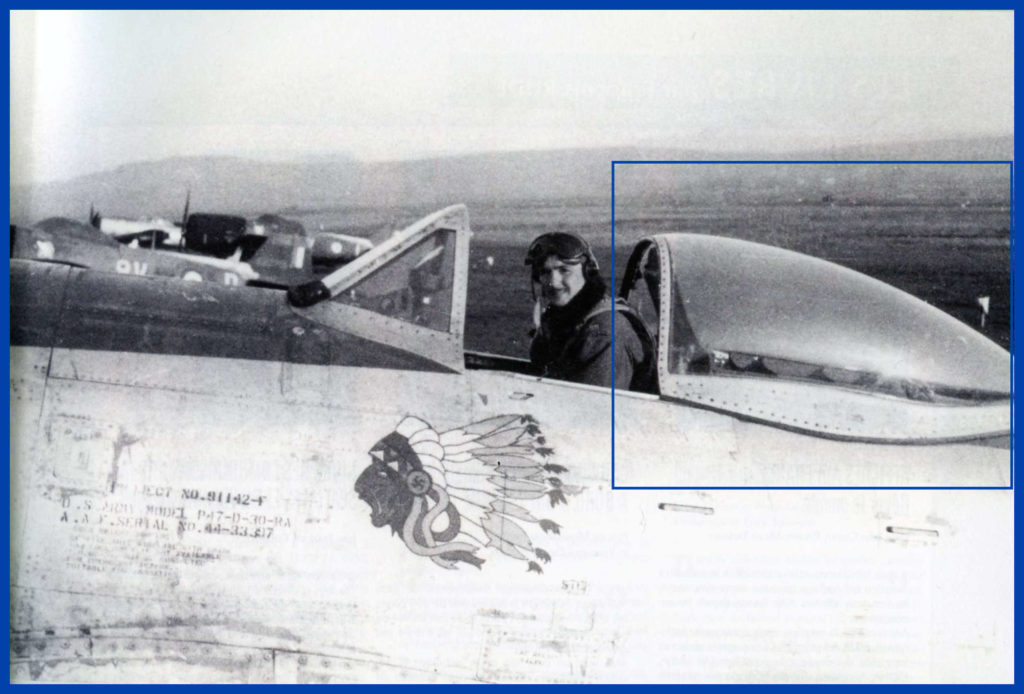

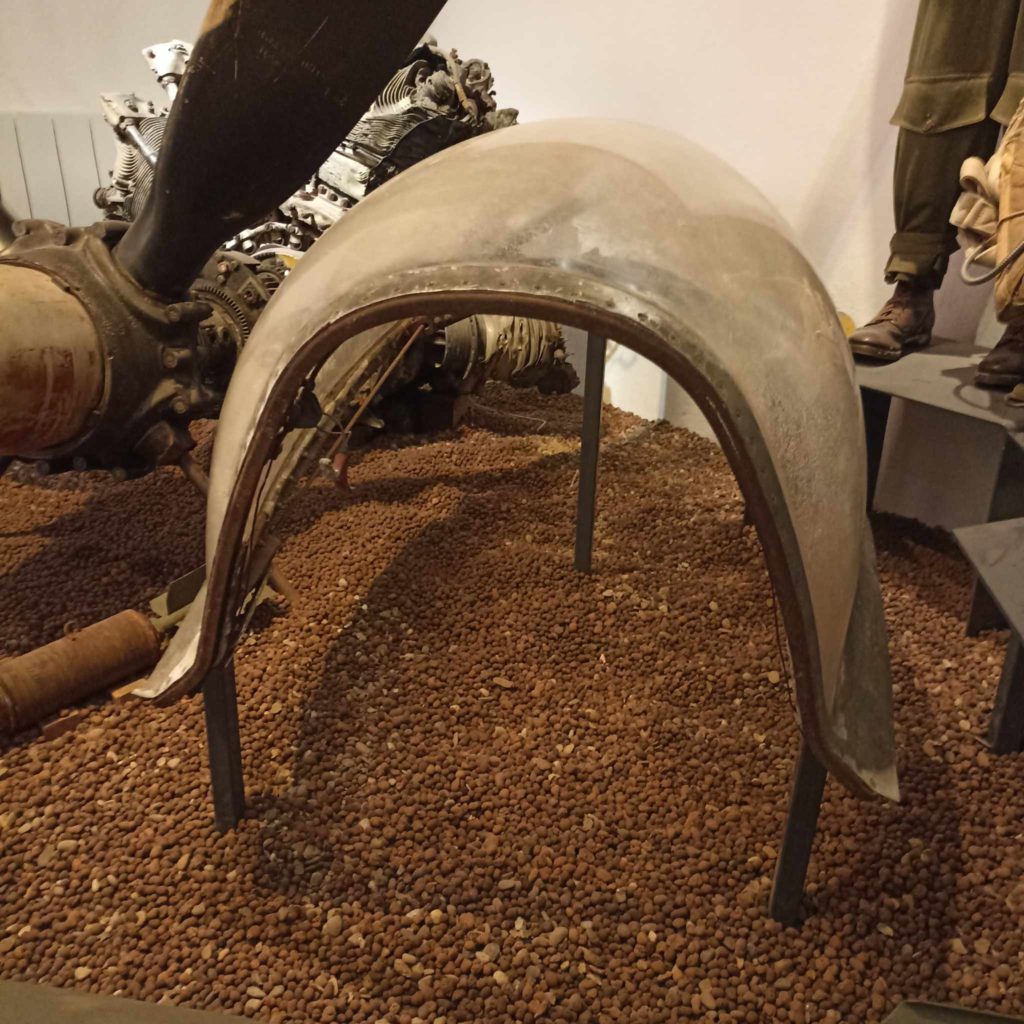
Antoine Marian CASTILLE 1919 – 2014
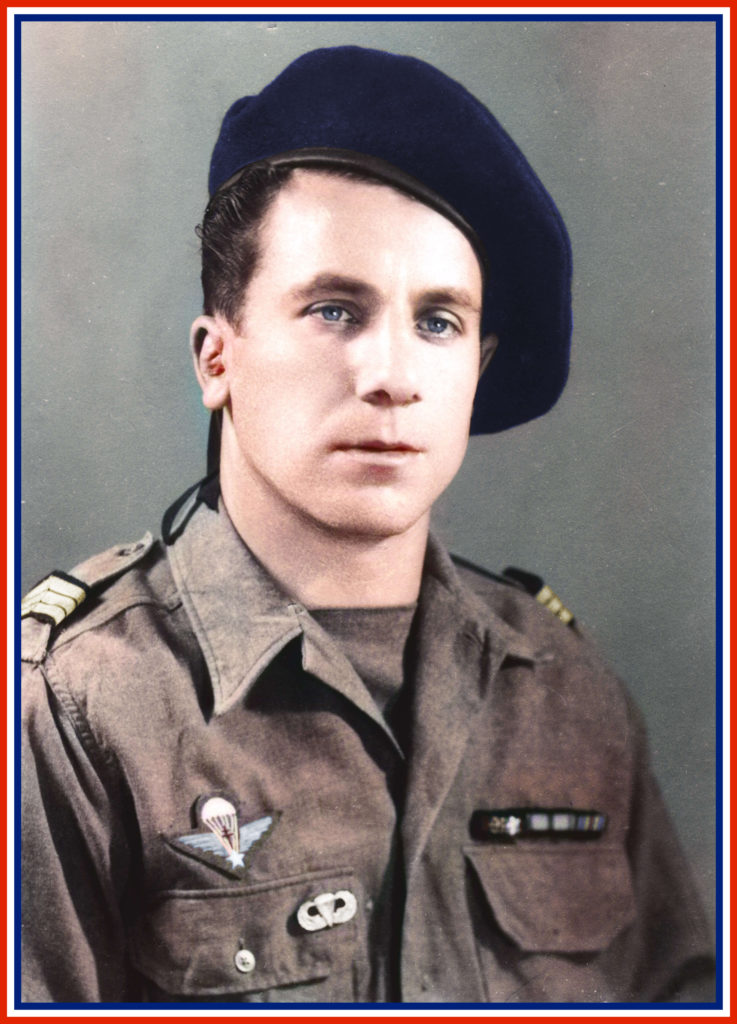
French by choice, French by bloodshed, he is an example of commitment to the France that became his homeland.
Antonio Mariano Castillo was born in Codos, Spain, on December 15, 1919, to Spanish parents who had met in Toulouse while working on the “war effort” required of the French during the 1914-1918 war.
Her mother’s first child having died during childbirth, she decided to return to her native village to ensure that the birth of the second would take place under the best possible conditions. This is why Antoine has Spanish nationality, even though he lives on French soil.
After wandering around various towns in the South-West of France, at the age of 10 he arrived in Luz-Saint-Sauveur, where his father found work in the post-war (1914-1918) hydraulic works.
As the son of immigrants, his first struggle began: he had to face the contempt of certain people and vexations… he was often called a “dirty Spaniard”. He learned the local dialect, which he would speak with his compatriots for the rest of his life. After studying at Notre Dame de Garaison (Hautes-Pyrénées), he worked in the building trades.
By decree of August 4, 1939, at his own request and by choice, he became a naturalized French citizen.
On June 8, 1940, he was drafted into the 183rd Infantry Regiment in Pau. Following the armistice of June 1940, after a short stint in youth work camps in Laruns (64), he joined the 27° Bataillon de Chasseurs Alpins (27° BCA) in Annecy, convinced that this unit, true to its motto “live free or die”, would soon take up arms against the invaders. A Pyrenean, a good mountaineer and an excellent skier, he became a non-commissioned officer with the rank of sergeant.
On November 11, 1942, German forces crossed the demarcation line.
General Valette d’Osia (commander at the time), who with the 27° BCA was beginning to organize the resistance in Haute Savoie and in particular on the Plateau des Glières, gave him the mission of returning to the Luz-Saint-Sauveur area to recruit men to continue the fight with the Free French. He convinced 40 young people from the Toy region (Luz-Saint-Sauveur canton) to take the path of exile and join the fighting units in North Africa. What’s more, as he knew the mountain roads in the Toy region inside out, he was asked to organize border crossings with Spain for refugees, pilots and volunteer fighters. Not limiting himself to a few people sent by the French Resistance, he also arranged for Polish people wishing to join their government in exile in London to resume the fight. His sustained activity did not go unnoticed in this small Pyrenean valley, and he was soon “burnt out”.
Denounced and accompanied by 20 companions in his charge, he crossed into Spain by night, via the Port Neuf de Pinède at the bottom of the Estaubé cirque, on June 2, 1943. He was arrested by Franco’s police, who saw only Communists among the defectors. He experienced the terrible internment in the sinister camps of Barbastro, Zaragoza and Miranda de Ebro. Mass was compulsory. Prisoners had to sing this religious service. They were also required to do the Fascist salute. The food was disgusting: the only dish served each day, called ‘rancho’, was a vague stew with one or two white beans swimming in it. To occupy his days, in addition to hunting lice and bedbugs, Antoine carves his aluminum bowl with a fork.
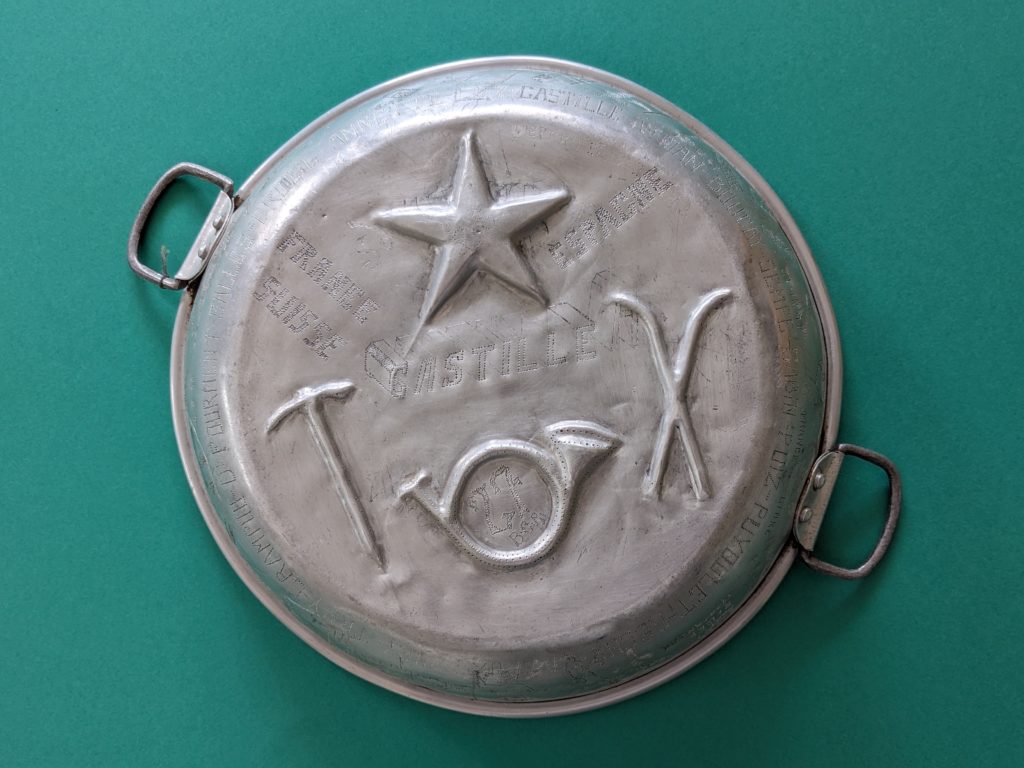
Exchanged by the Americans for sacks of wheat, he finally arrived in Marrakech (Morocco).
An experienced non-commissioned officer (a highly sought-after skill at the time), he was recruited as an instructor with the 6th Rifle Battalion. He soon realized that if he stayed on, he’d be spending the rest of the war instructing recruits and tidying up military affairs, which was not his objective.
Determined to fight, he “deserted” from the 6th Battalion of Tirailleurs to join a fighting unit in Algeria as soon as possible. With the help of Professor Laffont, a native of Luz who was Dean of the Faculty of Medicine in Algiers from 1945 to 1949, he joined the French Commandos in training at Staouéli. He was assigned to the 2° Commando (2nd company). This was a parachute unit designed to be dropped on the rear of enemy troops in order to disorganize their defenses. It was planned to parachute into the Vercors. There, he learned the silent techniques of hand-to-hand combat, using his bare hands or daggers to silence a sentry. As the war unfolded, this unit, which never parachuted onto the enemy, almost missed its rendezvous with history. It would not be involved in the fighting for liberation until November 1944.
In early October, his unit landed at Toulon. It headed up the Rhône valley to Alsace, where it was to be engaged. On November 1, fighting began at Haut-du-Tôt, killing 24 commandos. It was there that he earned his first citation.
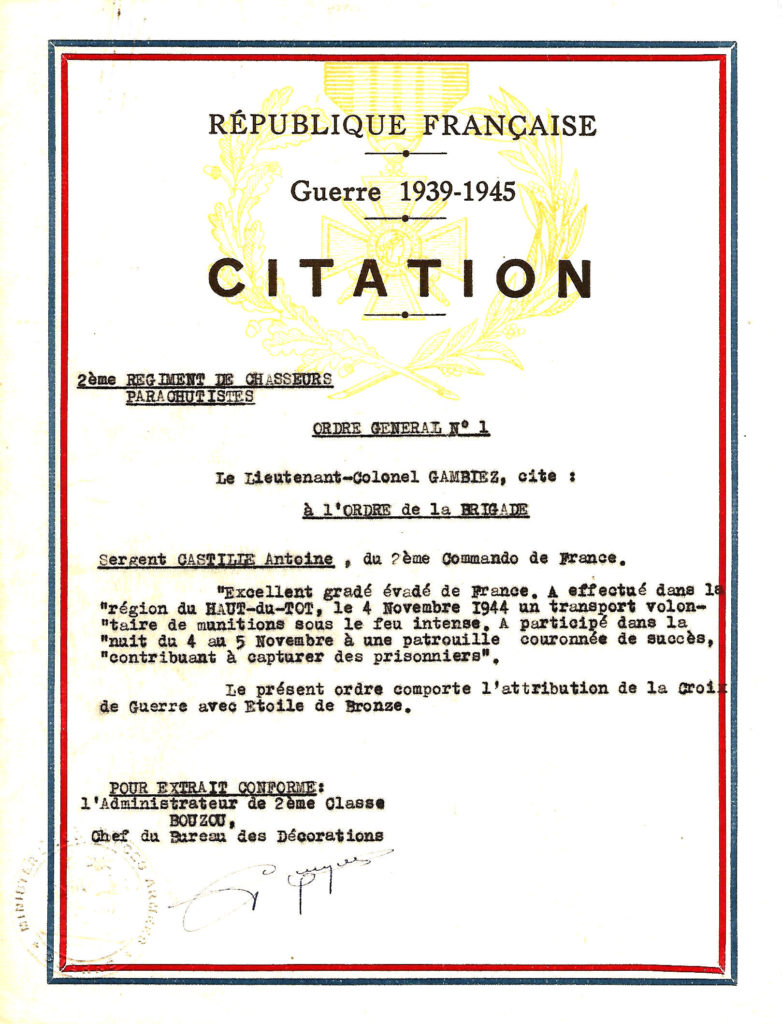
From November 6 to 17, he takes part in the fighting for the liberation of Belfort, in which his unit loses 16 men.
From November 23 to 27, operations at Masevaux claimed a further 16 casualties.
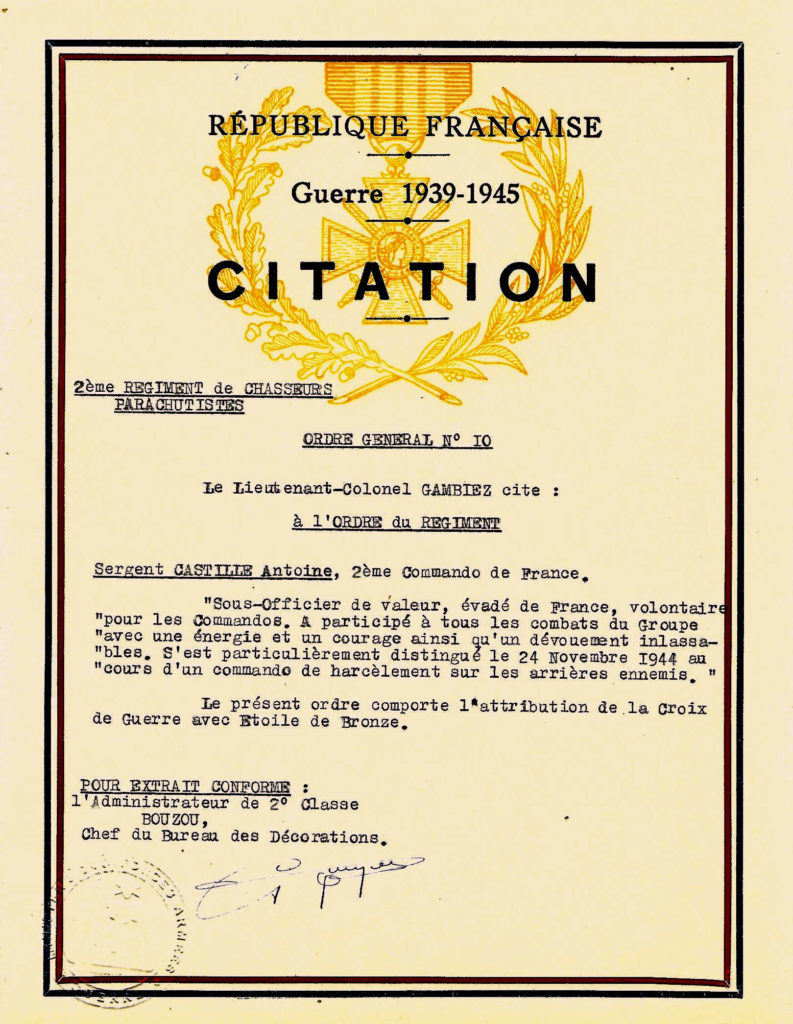
From December 7, 44 to January 20, 45, the unit was rested for reorganization to fill the gaps left by the dead and wounded, and leave was granted. Young recruits, supervised by veterans, were integrated into the unit to prepare for the actual fighting in the Colmar pocket. It was on this occasion that Antoine Castille was promoted to the rank of master sergeant.
He didn’t have long to show off his new stripes in combat. On the very first day of the Durrenentzen offensive, January 31, 1945, he was seriously wounded. For him, the war ended there: he was hospitalized and operated on (a steel plate was placed on his spine). The battles for Durrenentzen were extremely deadly, and the commandos suffered around forty casualties.
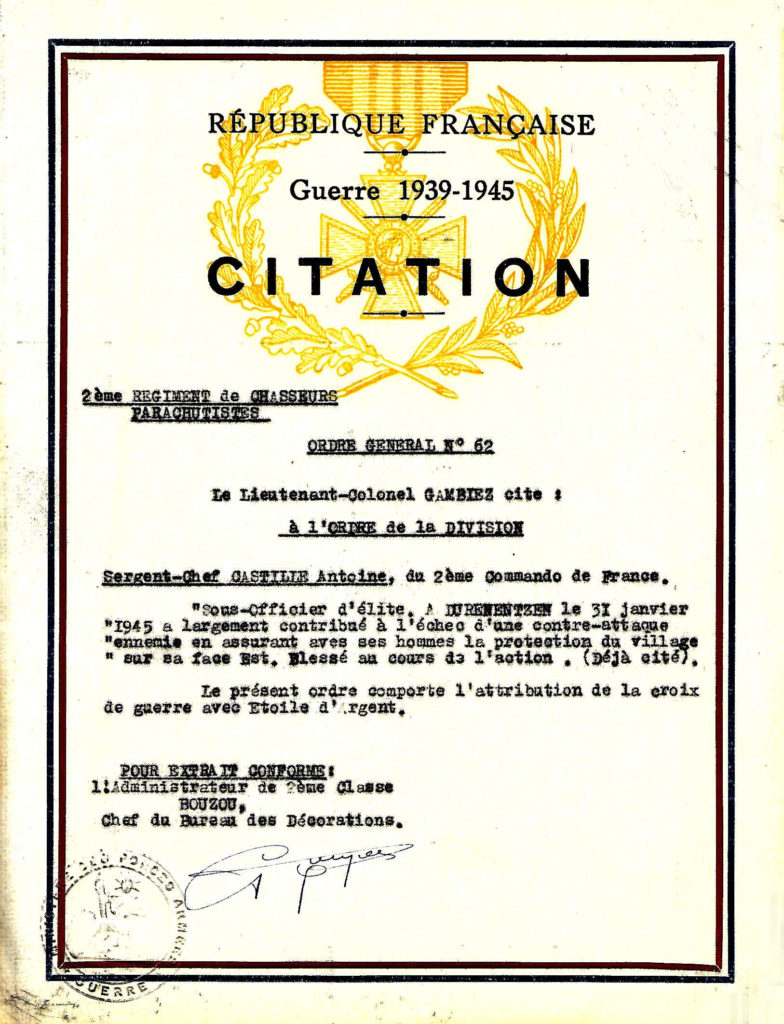
Antoine Castille was cited 3 times between November 3, 1944 and January 31, 1945. Later, for his acts of resistance, a 4th citation in the army order, with the award of the Chevalier de la Légion d’Honneur cross, rewarded his courageous clandestine actions. Poland awarded him the Polish Resistance Medal for helping its fighters cross the border.
In August 1945, he was appointed warrant officer and assigned to the 1st Airborne Shock Regiment. On January 1, 1946, he joined the 2° Régiment de Chasseurs Parachutistes, then a little later the 3° Groupement Aéroporté at Bayonne.
The serious after-effects of his injuries forced him to turn his career towards administration. He was assigned to the Army’s Military Personnel Department and the Army General Staff. In January 1953, he was appointed Chief Warrant Officer. Despite being physically unfit to serve overseas, he spent 2 years in Algeria, where he was on the staff of the 10th Military Region from 1958 to 1960. In 1967, after a further 7 years’ service with the French Army Staff, he was retired.
He married Denise on May 8, 1948, and from this union a daughter named Muriel was born in 1949.
In 1970, by decree of April 18, Antonio Mariano Castillo became Antoine Marian Castille. It was recognition, the end of a tenaciously fought battle, the victory of merit. This honor was recognized by his appointment to the rank of Officer of the Legion of Honor in 1987. He holds 13 official decorations.
Every year, in November and December, he and his surviving comrades-in-arms return to the battlefields to plant flowers on the graves of their fallen comrades and sing the “Marche des Commandos”, composed by Schmidlin de Franck, who died in action at Essert, with lyrics by Yves de Kermoal.
Far from the noise and horrors of war, he organized his retirement in Toy country around nature (fishing, hunting, skiing, hiking). He hangs a war trophy on the mantelpiece in the living room, consisting of 4 daggers taken from German officers and his commando dagger.
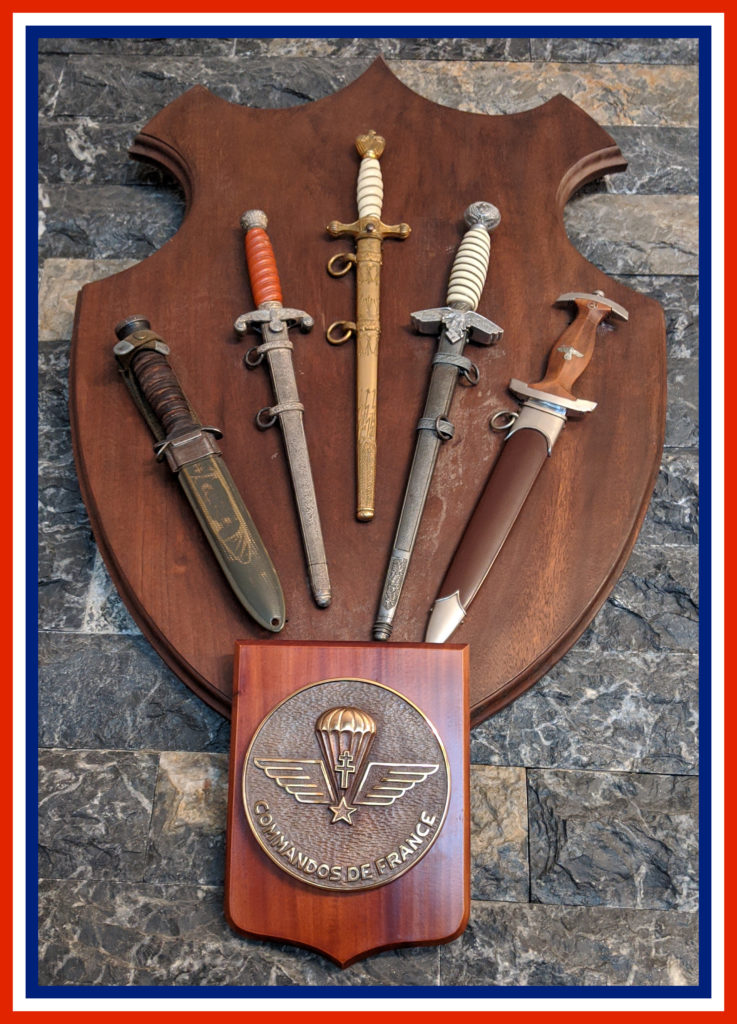
After a long and peaceful retirement, he died on September 5, 2014 at the age of 95.
He worked all his life for the freedom of his homeland, perpetuating the memory of those who gave their lives for France. To ensure that younger generations do not forget the exemplary sacrifice of our elders, and true to his commitments as a soldier, he is present at all patriotic ceremonies. He is one of the founding members of the “Commandos de France” association, and its first President.

Décorations officielles d’Antoine CASTILLE :
Officier de la Légion d’Honneur
Médaille Militaire
Croix de Guerre avec palme
Croix du Combattant Volontaire 39-45
Croix du Combattant
Médaille des Evadés
Croix de Combattant Volontaire de la Résistance
Croix des Internés de la Résistance
Médaille commémorative 39-45
Médaille de bronze de l’Education Physique
Médaille des blessés
Médaille commémorative d’Algérie
Médaille de la Résistance Polonaise
Our sincere thanks to Mr and Mrs Haffner (Antoine Castille’s daughter) for writing and sharing the story of Antoine Castille, one of our brave and valiant liberators, who will remain with his comrades in our memories.
Sherman M4A4 n°6 “Renard”

SHERMAN M4 A4
SHERMAN M4 A4
The M4 A4 model was manufactured in 7,500 units between June 1942 and August 1943 by “Detroit Tank Arsenal” (Chrysler’s Detroit subsidiary) in Michigan, which was the largest manufacturer of Sherman tanks during the Second World War (18,000 out of 50,000 units).
Features :
Crew: 5 (1 tank commander – 1 gunner – 1 radio – 1 pilot – 1 assistant-pilot).
Length: 6.06 meters
Width: 2.62 meters
Height: 2.85 meters
Weight: 30 tons, including 4 tons for the turret.
Armament: 1 x 75mm cannon, 2 x 30-calibre (7.62mm) machine guns and 1 x 50-calibre (12.7mm) machine gun.
Engine: Chrysler type Multibank A57, 525 hp.
The history of the “RENARD” tank… n°420243…of the 1er Régiment de Chasseurs d’Afrique.
The Sherman “RENARD” tank (for the man of letters Jules Renard 1864-1901) is one of the command tanks of the 1er Régiment de Chasseurs d’Afrique (1er RCA), grouped in a platoon of 4 tanks, including the REGNAULT (for the physicist Victor Regnault 1810-1876) and the RENAUDOT (for the physician-journalist Théophraste Renaudot 1586 – 1653). This platoon was most often used to reinforce the 2nd squadron.
Leaving Oran (Algeria) on the US Navy’s Landing Ship Transport (LST) 907, the 1st RCA landed at Sainte-Maxime, regrouped at Salon de Provence and reached the Besançon sector by rail (stationed at Port d’Atelier in the upper Saône).
The “Renard” had its baptism of fire on November 14, 1944, near Ile-sur-le-Doubs. It fought in the Dampierre forest and entered Montbéliard on November 17, 1944. It took part in the battle of Granvillards before arriving in Alsace, where it was engaged at Seppois-le-Haut, Bernwiller and Guewennatten, before establishing liaison with troops coming from Masevaux.
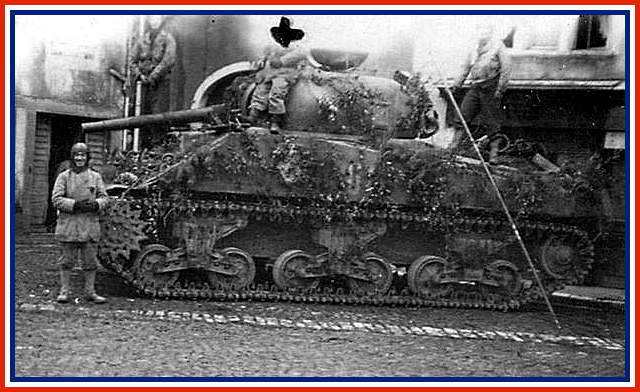
The Combat Command 5 (CC5), to which the 1er RCA belonged, left Traubach-le-haut on December 14, 1944 to join Arnould (via Belfort, Lure, Epinal and St-Dié).
On December 16, 1944, the “Renard” arrives at the Riquewihr pass (Lt de Roux becomes tank commander at Riquewihr), dives into Kientzheim and takes up position behind the ADAM Charles house, where it gets bogged down. Barely able to get out of the way, it targeted a Panzer V “Panther” camouflaged near KUEHN Charles’s building, which had just destroyed the Tank Destroyer M10 “Eylau” of the 11th RCA near the railway station.
After an exchange of fire, the German tank withdrew to Kaysersberg. As for the “Renard”, it spent the night in the shelter of the château park’s boundary wall. The crew slept on the ground, on the sidewalk, reassured by the presence of the French Foreign Legion.
On December 18, the “Renard” made its way up the Grand’Rue, while the Bourgin sub-group was massed on the Place de la Porte Haute…the attack on Kaysersberg began with a barrage from the artillery posted south of Riquewihr. Source: based on Auguste PROUX’s account).
The crew of the “Renard” on December 18, 1944, during the attack on Kaysersberg was as follows:
Adjudant Henri BARBANTON, tank commander, replacing Lt de ROUX, who was called to other duties following the death of Lt DUTILH).
Gunner, Brigadier Auguste PROUX.
Pilot, hunter 1st class André SOUBEYRAN.
Pilot’s assistant, chasseur DEGRES.
Loader, chasseur CHAILLET LEGER.
On December 18, 1944, the 2nd squadron of the 1st RCA, reinforced by the Valettes platoon of the 4th squadron and a section of the RMLE, attacked the eastern entrance to Kaysersberg at around 9am.
Lieutenant de Roux’s platoon led the 4-tank unit and took to the vineyard path known as the “Bari-way”, with the “Renard” tank in second position.
At Jean-Paul SICK’s vineyard, the dirt road collapses under the weight of the tanks. The lead tank was immobilized and immediately hit by fire from a Panzer V “Panther” ambushed behind the anti-tank barrage on the eastern outskirts of Kaysersberg (currently level with the post office).
The situation for the “Renard” was not much better, as the 2-meter-high retaining wall had given way and the tank had slid into the vineyards below. Despite this uncomfortable position, he fired at the German tank, which returned fire and hit him…the “Renard” was on fire!
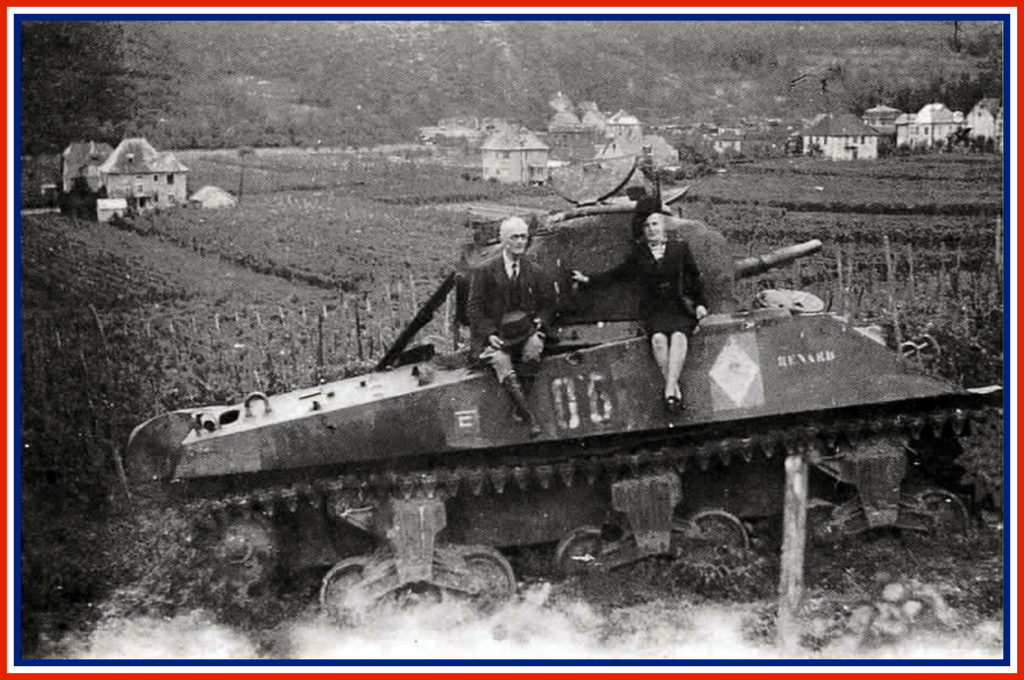
Brigadier PROUX decides to stay in the tank despite the imminent risk of explosion, and continues firing with little chance of destroying the “Panther” given the thickness of its armour (the Sherman’s 75mm shells cannot pierce the front armour of this type of tank). The rest of the crew decided to continue the fight on foot.
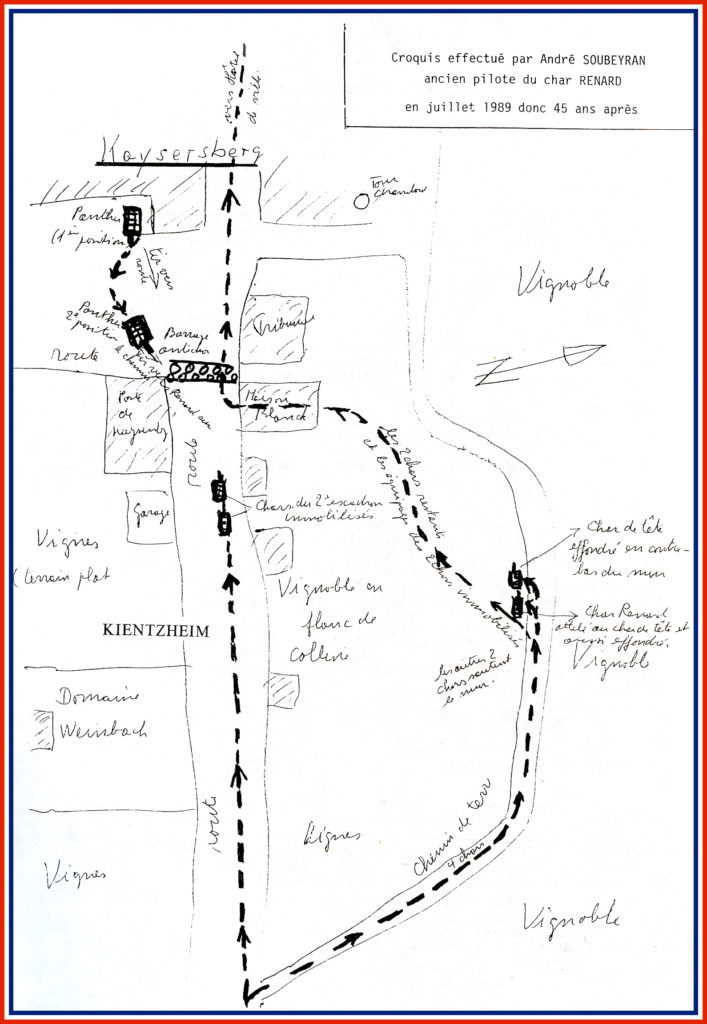
Hit by several shells, without much damage, the German tank continues to fire.
Luckily, a shell fired by Brigadier PROUX ricocheted off the lower part of the Panzer’s gun mask, piercing the German tank commander’s turret and killing him instantly. The rest of the crew then abandoned the Panther and took refuge in the cellar of the post office, where they were taken prisoner by the crew of the “Renard”.
During this battle, two other French tanks arriving by the main road were destroyed: the “FAYOLLE” and the “FAIDHERBE”.
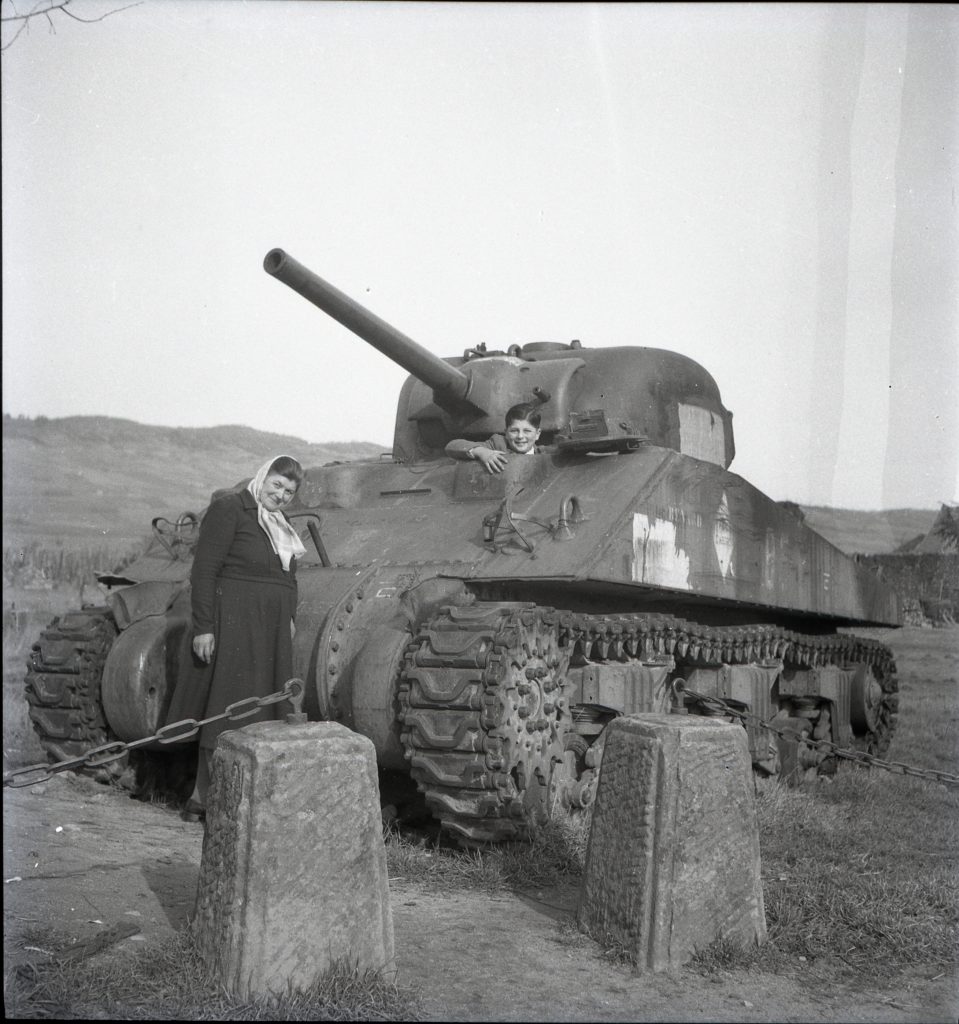
The German tank is still operational and is recovered by the Avout squadron of the 1st RCA, which renames it “KAYSERSBERG”, after the just-liberated town.
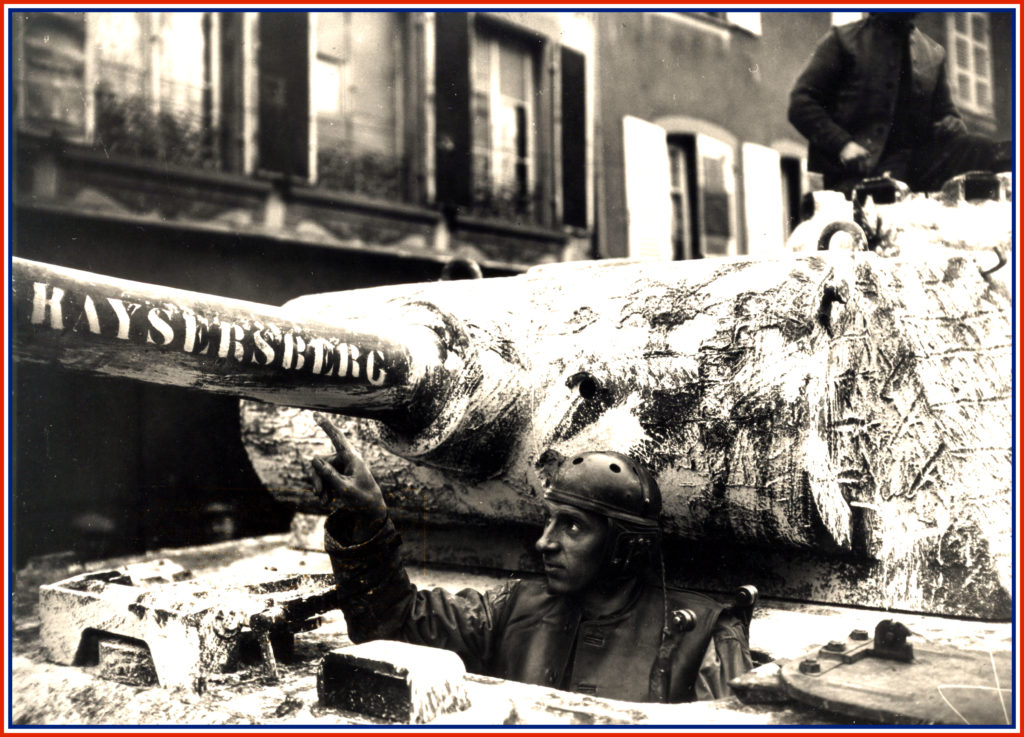
It was not engaged in combat, but was occasionally used as a tow truck (not to mention the difficulties of driving around with an enemy vehicle of this type in the middle of the battle to liberate the Colmar pocket).
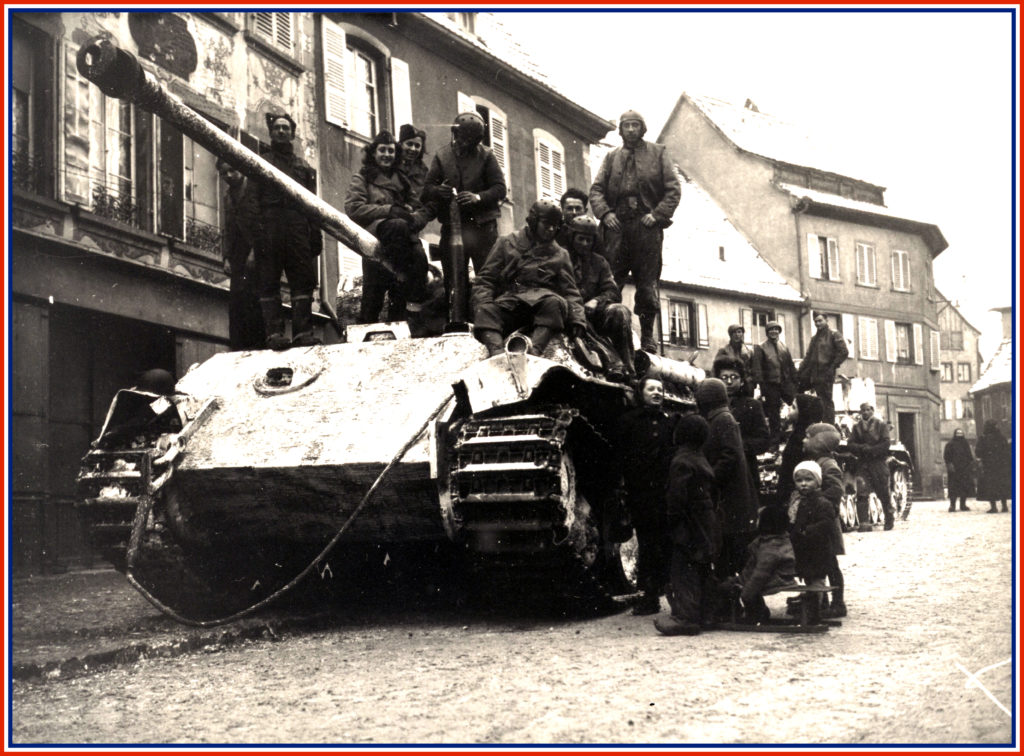
It was abandoned (engine failure) in the Lauterbourg sector on April 4, 1945, when the 1er RCA crossed the Rhine.
In November 1962, the “RENARD” tank was restored by a team led by Captain Léon BERRIER (a veteran of the 1er RCA), then stationed with the 8th Hussars regiment at Colmar. It was installed at its current location, on the western outskirts of Kientzheim.
In his speech at the ceremony on February 6, 1966, General Schlesser described the “RENARD” tank as “the monument to the glory of the 5th French Armored Division”!
In agreement with the civil and military authorities, the former members of the 5th DB decided to meet every year for a remembrance ceremony on December 17… which they did from December 1966 until the last liberators disappeared.
sources: “Le char Renard – sherman M4A4” by the Kientzheim historical society, 1989 – internet – private collection.
